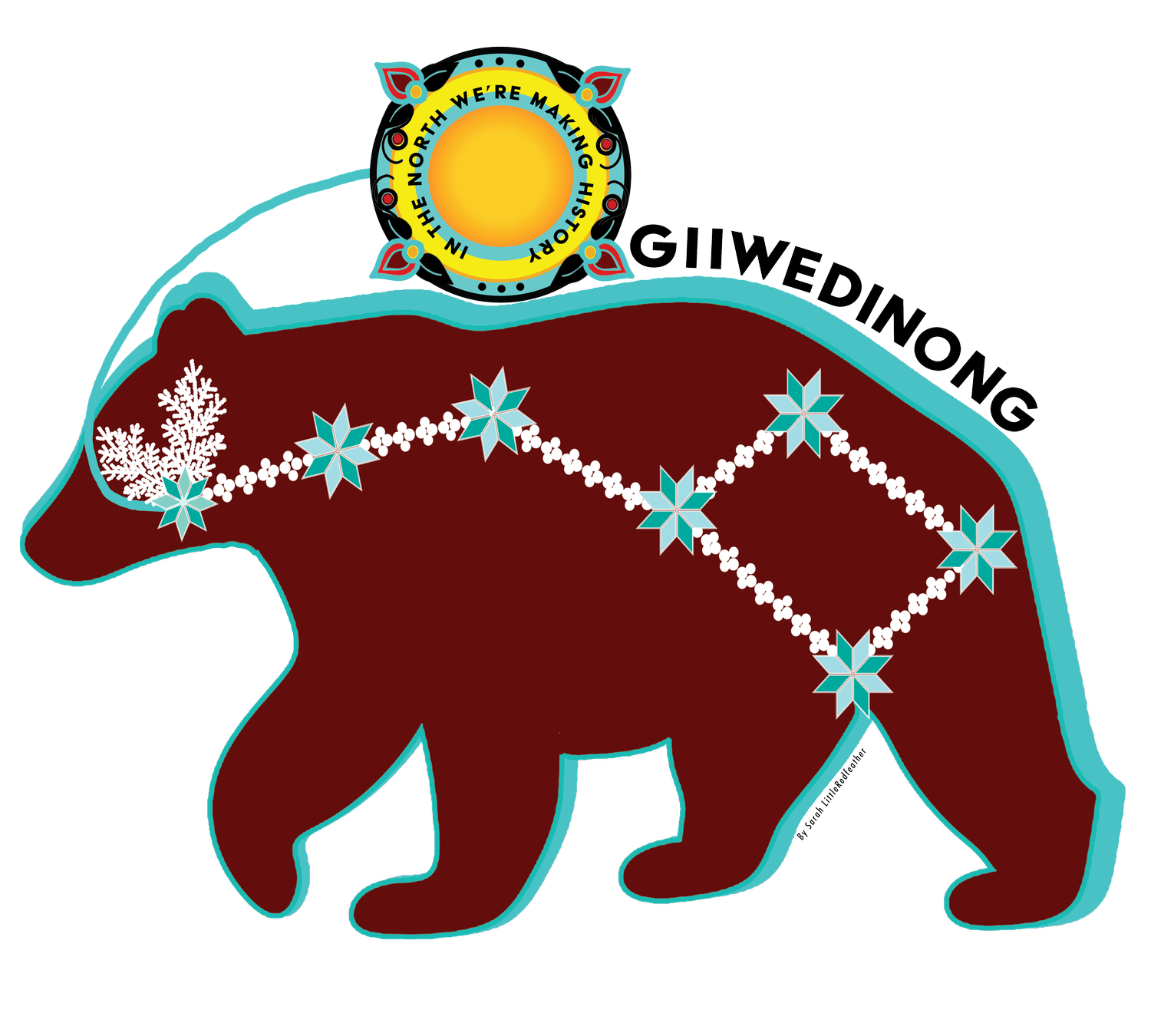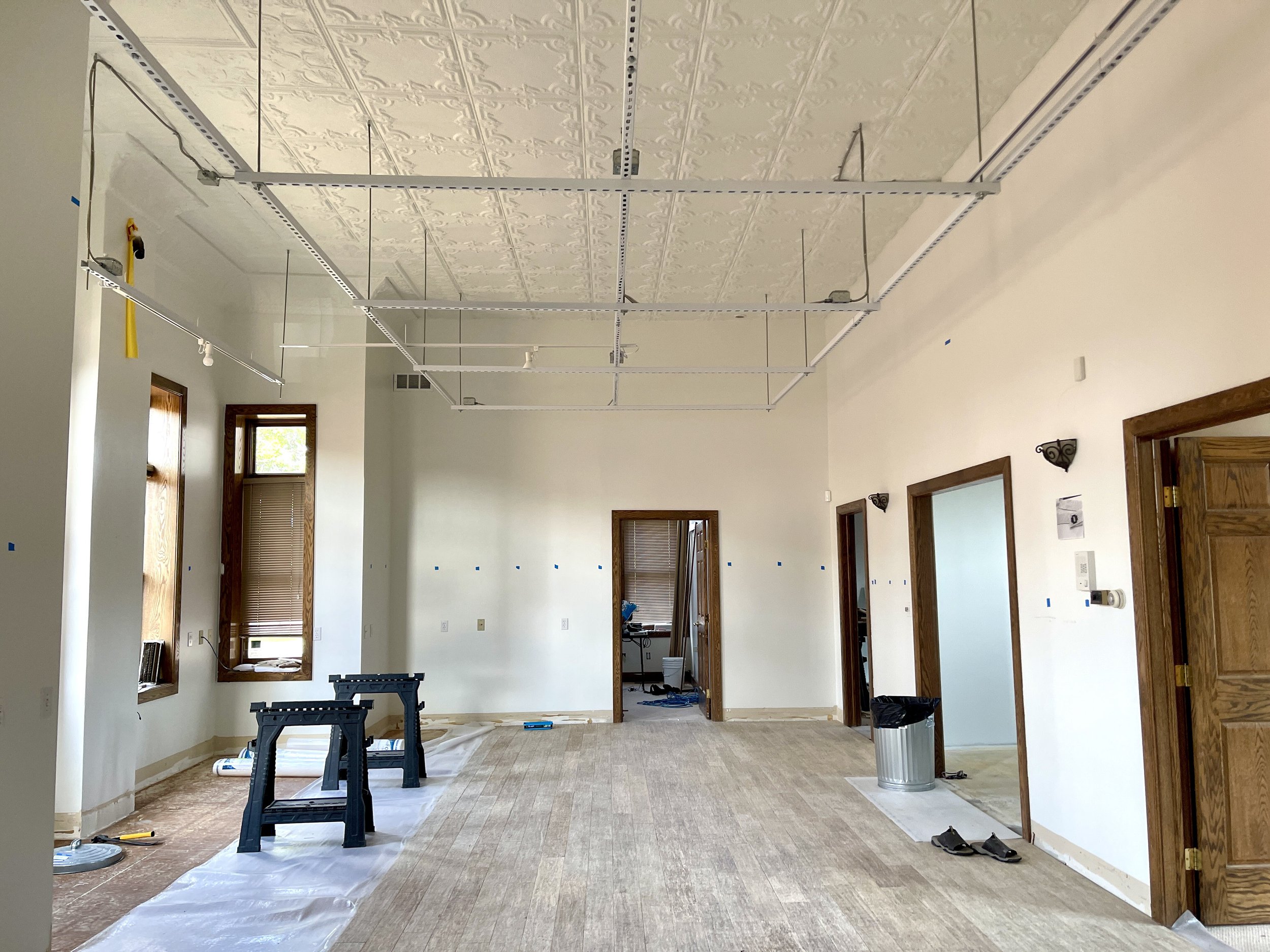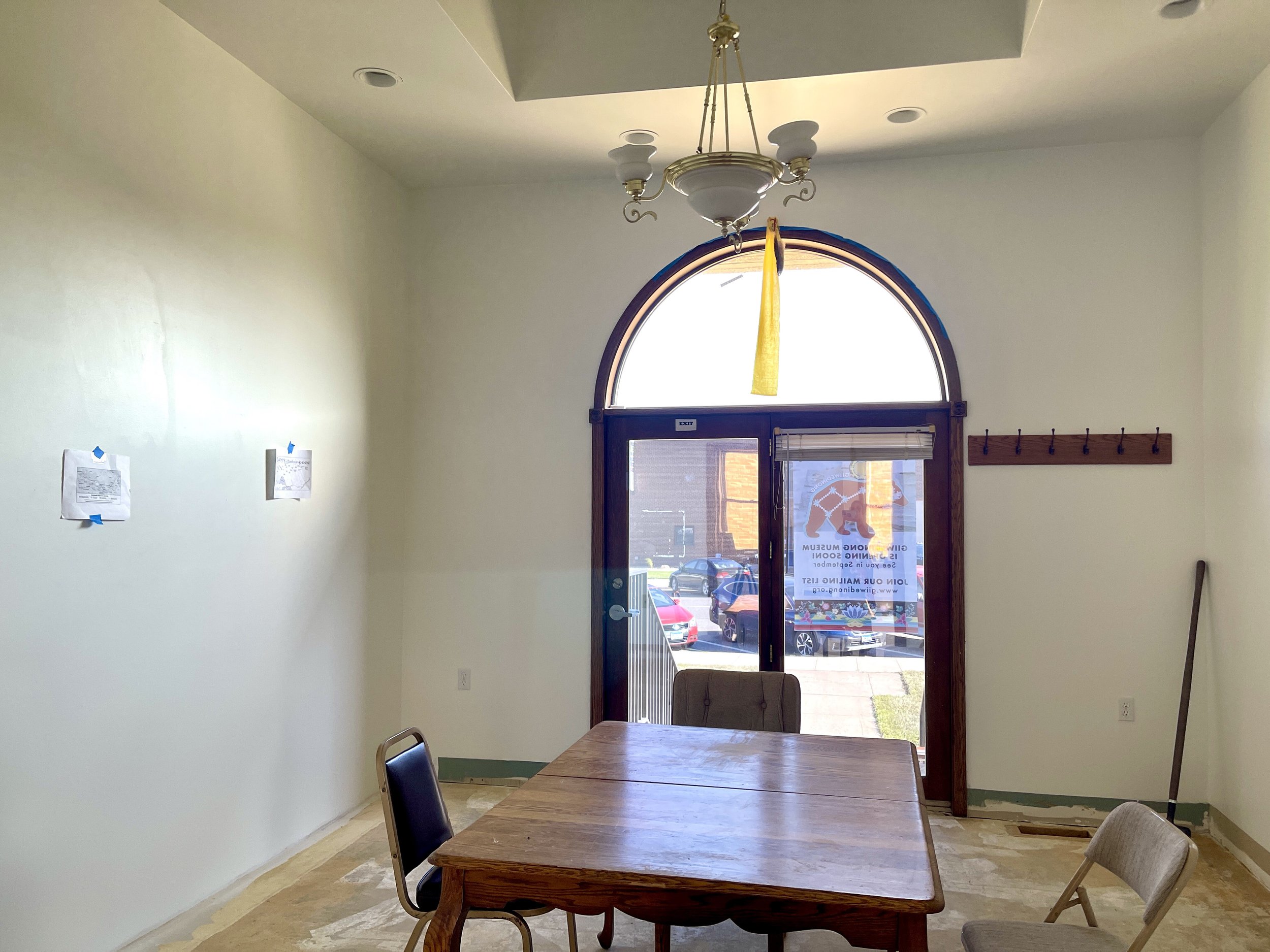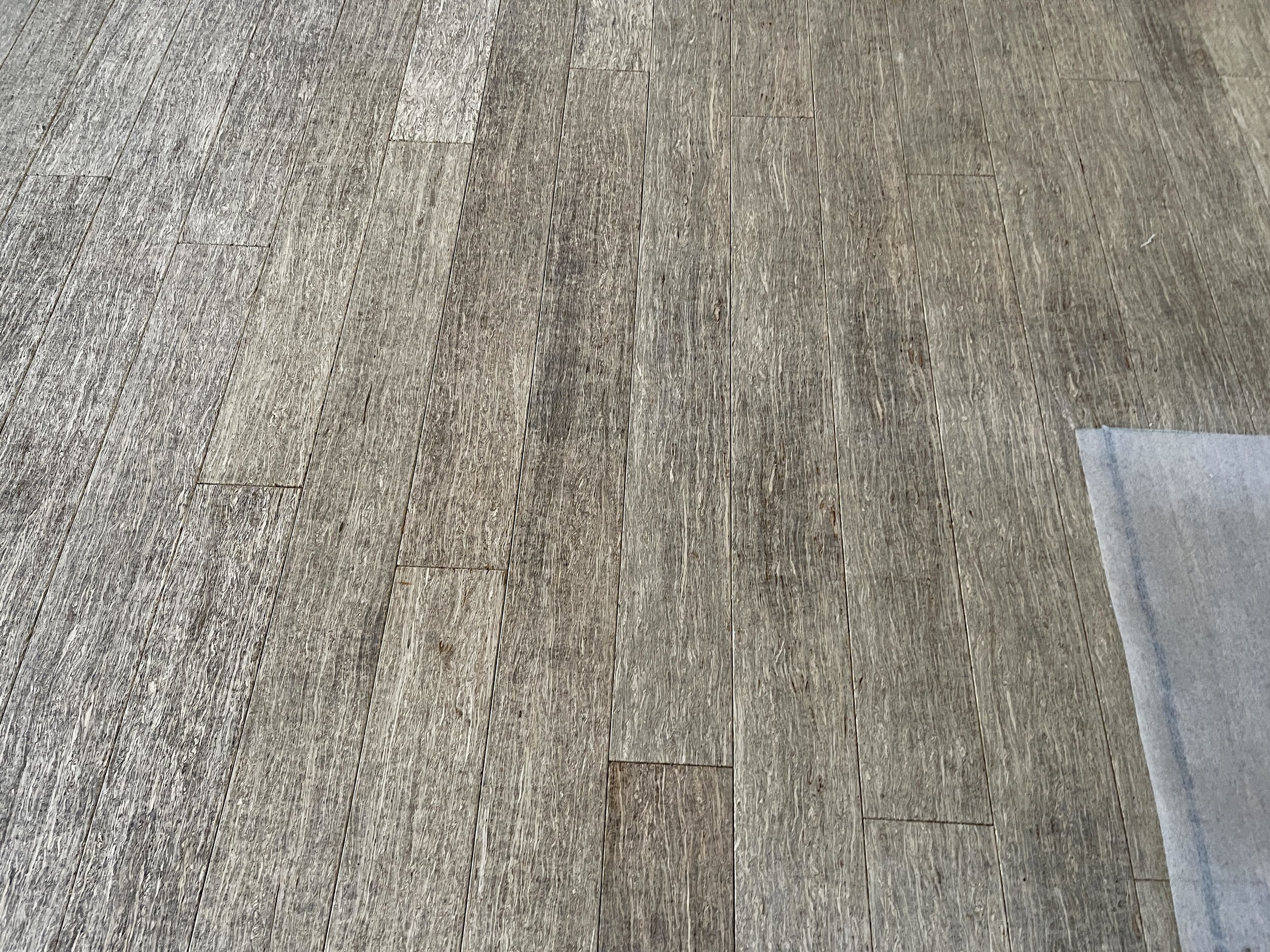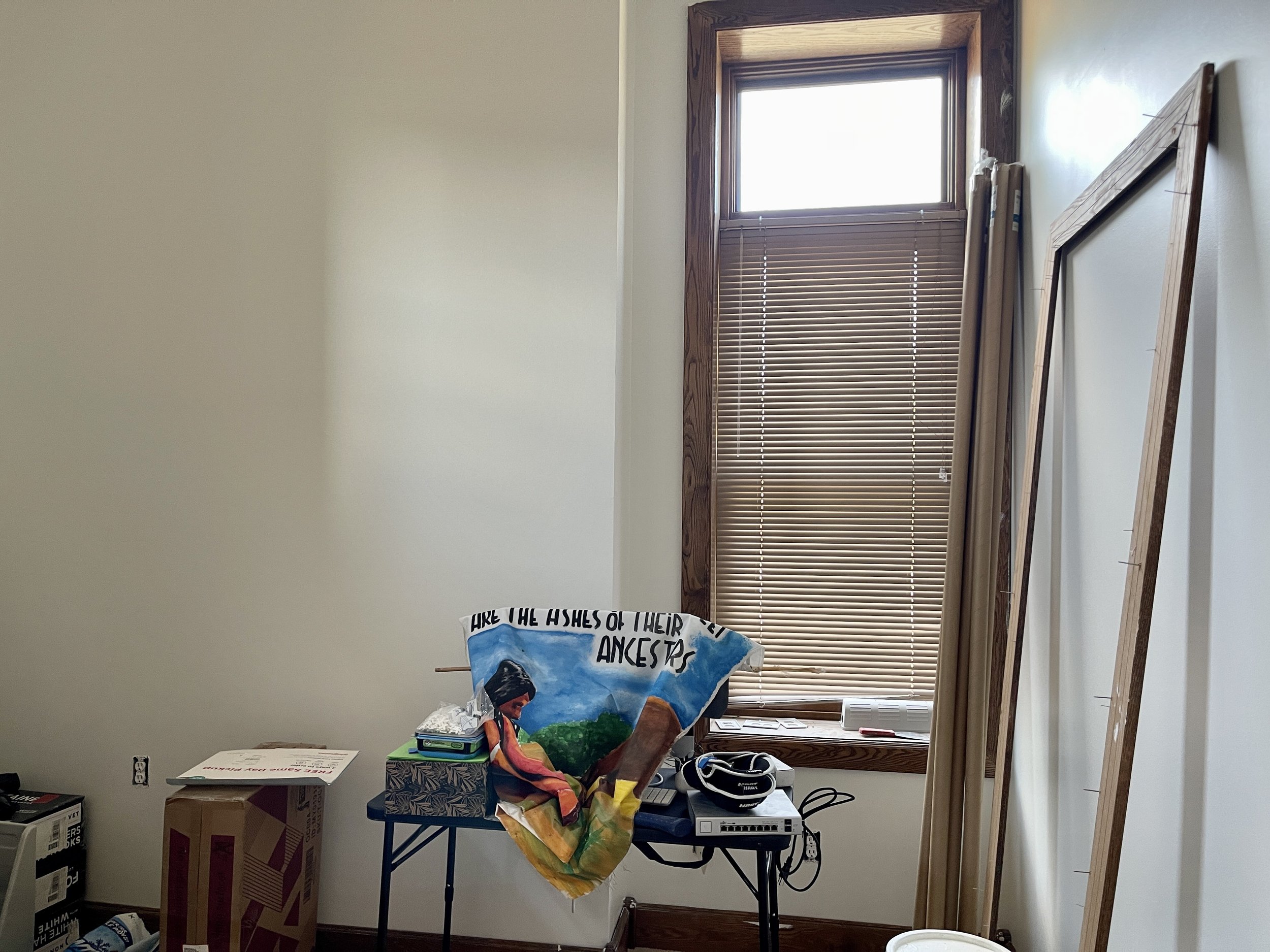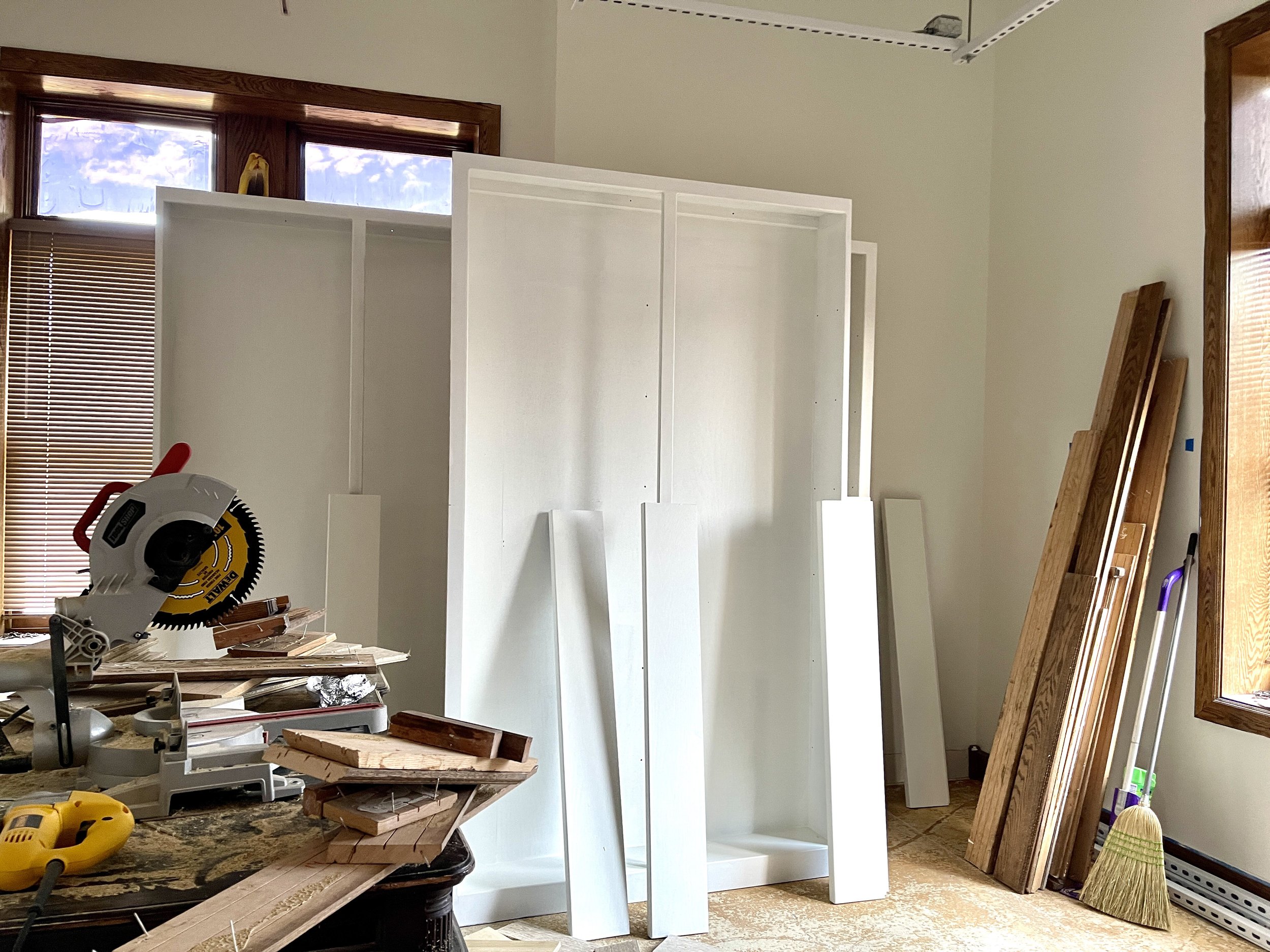Rethinking Thanksgiving Celebrations: Native Perspectives on Thanksgiving
Rethinking Thanksgiving Celebrations: Native Perspectives on Thanksgiving.
Publication and educator resources by the National Museum of the American Indian—Smithsonian.
Publication by the National Museum of the American Indian
The "First Thanksgiving" is often portrayed as a friendly harvest celebration where Pilgrims and generic, nameless Indians came together to eat and give thanks. This story is a myth that was sparked in the mid-1800s when English accounts of the 1621 harvest event resurfaced and fueled the American imagination. Romanticized paintings and stereotypical images of "Pilgrims" and "Indians" celebrating the "First Thanksgiving" became part of the national nostalgia and Manifest Destiny sentiment as the United States pushed west.
Sarah Josepha Hale, an influential editor of a magazine called Godey's Lady's Book, led a campaign for a national Thanksgiving holiday, and the "First Thanksgiving" myth played into her agenda. In 1863, President Abraham Lincoln declared a national Thanksgiving in November to celebrate gratitude and unity amidst the turmoil of the Civil War. In the decades that followed, the "First Thanksgiving" myth and the national holiday evolved into a foundational, national story reinforced by memorials, holiday marketing, literature, and school curriculums.
The "First Thanksgiving" as a national story is incomplete and inaccurate. The whole history is more complex and includes the Wampanoag voice and perspective that have been largely absent from this narrative. The Wampanoag and neighboring Native nations were interacting with European explorers, traders, and enslavers for nearly one hundred years before English settlers arrived at the Wampanoag village of Patuxet in 1620. After careful observation, negotiations, and exchanges, the Wampanoag decided to assist the English settlers. However, their interactions had much more to do with political alliances and diplomacy than a budding friendship. Cooperation and peace were short-lived.
To learn more about the true history that goes beyond a shared meal in 1621, see our inquiry-based resource The "First Thanksgiving": How Can We Tell a Better Story? for grades 3–5.
Harvest ceremonies and festivals have been an integral part of Wampanoag lifeways for thousands of years. The Wampanoag practiced daily and seasonal traditions of giving thanks long before the encounter with English settlers and the formation of Thanksgiving as a national holiday.
Learn the significance of Cranberry Day for the Aquinnah Wampanoag and the importance of harvest traditions among Wampanoag communities today.
Giving thanks is a longstanding, central tradition among Indigenous peoples that is still practiced today. Native traditions are distinct, complex, and specific to each individual nation.
Read and discuss the Haudenosaunee Thanksgiving Address with your students. This expression of gratitude is recited by the Haudenosaunee at community gatherings throughout the year.
As educators, we should select books and other materials that feature accurate and tribally specific portrayals of Native people, both past and present. NK360° collaborated with Dr. Debbie Reese (Nambé Pueblo) of American Indians in Children's Literature to develop a rubric that outlines five criteria groups to consider when selecting additional Native American Literature in Your Classroom.
Projects and crafts that attempt to adapt or copy Native traditions often perpetuate stereotypes and misunderstandings of Native cultures. We discourage adopting "Native" costumes or crafts into your classroom. For more information, please see our Native American Cultures and Clothing: Native American Is Not a Costume guide. Instead, we encourage you to celebrate the vibrancy of Native cultures with some of these resources while you celebrate Thanksgiving and throughout the year.
Giiwedinong Celebrates 3rd Annual Días de los Muertos (Day of the Dead) Block Party!
Miigwech to all of the wonderful communities who joined us for our 3rd Annual Días de los Muertos (Day of the Dead) Block Party! We sincerely hope that everyone had a truly great time celebrating and honoring their loved ones who have sadly passed on.
Miigwech to all of the wonderful communities who joined us for our 3rd Annual Días de los Muertos (Day of the Dead) Block Party! We sincerely hope that everyone had a truly great time celebrating and honoring their loved ones who have sadly passed on.
Your enthusiastic participation and kind support truly made this event a truly unique and memorable experience for everyone involved, fostering enduring relationships and priceless moments that all attendees will undoubtedly remember fondly for years to come.
The impact of your engagement will resonate with us, enriching our community and fostering a sense of togetherness that we deeply value.
We are particularly grateful to Vallartas Mexican Grill for providing us with delicious food, to Ana and Guillermo for graciously sharing their vibrant culture and artistic talent, to the Armory Arts & Events Center for kindly opening their space for us all to gather and celebrate, to the Horse Nation Academy and their beautiful ponies and horses for adding an extra element of joy, and most definitely to all the volunteers who worked tirelessly to make it all happen.
The connection we have with our relatives of the indigenous peoples of México and the Michoacán or Anishinaabenowin, 'Memengwaa,' traveling from the north to México, arriving at the time of Días de los Muertos for the winter.
In March, the Memengwaa (Monarchs) begin their return to North America. They lay eggs and nectar as they migrate. We look forward to welcoming the Memengwaa (Monarchs) next year and another Días de los Muertos gathering.
Migrating monarch butterflies return to Mexico each year around the same time as Día de Muertos, a celebration from November 1st to 2nd honoring the dead. Families gather at gravesites, creating altars with photos, offerings, sugar skulls, marigolds, and candles, sharing food and stories to remember loved ones.
Historian Chavez noted that for the Purepecha and Mazahua people of Michoacán, the butterfly's arrival signals the corn harvest and is seen as the souls of the deceased visiting for Día de Muertos.
However, monarch butterfly populations face significant threats from various human activities, including the use of BT corn, as well as mining and logging practices in their habitats. These challenges highlight the urgent need for their protection and preservation. It is essential to understand why we should honor our relatives in nature and take active steps to care for them.
Video of Day of the Dead Michoacán México.
This is a great video story to share with your families about the history and culture.
Park Rapids First Annual National Day of Racial Healing hosted by Giiwedinong Treaty Rights & Culture Museum.
Giiwedinong Treaty Rights & Culture Museum in Park Rapids, MN celebrated the inaugural National Day of Racial Healing on Tuesday, Jan. 16, with shared food, a tour of the museum and discussion of ways the community can build together across racial boundaries.
“Yesterday was Martin Luther King Day, and so people generally get this sense of the struggles of racial justice. Today is a day to kind of reflect on that,” said co-curator Winona LaDuke. “The (W.K.) Kellogg Foundation sponsors it nationally, and part of our work is funded by Kellogg. So I said, let’s do that.”
LaDuke showed a small group of guests the “One Dish One Spoon” wampum belt – a treaty belt given to the Anishinaabe people by members of the Iroquois Confederacy in 2021.
On Tuesday, January 16, 2024, Giiwedinong hosted the First Annual National Day of Racial Healing event. The event celebrated a teaching of the One Dish One Spoon Treaty, and shared a traditional meal based on One Dish One Spoon Treaty which was Hominy Beaver Tail soup.
Our visitors that attended were from the Park Rapids Arts & Culture Commission, Laura Grisamore, LuAnn Hurd-Lof, Liz Stone, Paul Albright, Carolynne White, Paul Dove and Pat Dove and Derek Ricke, President of Park Rapids Chamber of Commerce attended Don Wedll, Giiwedning Board Chair, Mary Crystal Goggleye, Leech Lake Band of Ojibwe, Sarah LittleRedfeather, Museum marketing and creative co-curator and Winona LaDuke, Museum research and co-curator.
We are grateful to have shared space on this National Day of Racial Healing (NDRH) and those who joined us.
This event was is in spirit of National Day of Racial Healing (NDRH). Which occurs annually following Martin Luther King Jr Day.
This day was established in 2017 by the W.K. Kellogg Foundation's Truth, Racial Healing, and Transformation efforts. Helping to carry on the dream of equity and inclusion for all.
One Dish One Spoon Treaty
By Winona LaDuke
In l70l, a Treaty was reaffirmed between the Anishinaabe and the Haudenosaunee Nations, what is now Montreal. Minwenzha, a long time ago, our people the Anishinaabe made an agreement with the Haudenosaunee nation, or the Six Nations Confederacy, referred to as the One Dish One Spoon Treaty or the Great Peace of Montreal. The year was l701. Canonized as an Indigenous law, it describes an agreement for sharing hunting territory among two or more nations. People are all eating out of the single dish, that is, all hunting in the shared territory. One spoon signifies that all peoples sharing the territory are expected to limit the game they take to leave enough for others, and for the continued abundance and viability of the hunting grounds into the future..
This Wampum belt represents a treaty between the Anishinaabe (the Three Fires) and the Haudenosaunee (the Six Nations Confederacy) first made 700-hundred or so years ago, and reaffirmed by the Indigenous nations generations after generation.
It describes an agreement for sharing hunting and harvesting territory.
This Wampum represents that people are all eating out of a single dish, that is the shared territory. In many traditions, serving from the same spoon means that people are relatives, and in this case, are expected to take only what is needed for the continued abundance and viability of the land into the future.
The belt was gifted to the Anishinaabe people of this region in 2021, when Joe Hill, a Seneca man, brought the belt to the Mississippi River, to reaffirm this Treaty between our peoples to protect the water. This is the Wampum Belt displayed here was accepted by Rice Lake and Sandy Lake Anishinaabe.
We all live here, drink the same water, breathe the same air, and basically are eating from the same bowl, “we are relatives.”
“The Two Row Wampum is about peace and friendship. As long as the grass grows green, water flows downhill, and the sun rises in the east and sets in the west, the wampum belt has meaning. It’s an agreement—you stay in your ship; we stay in our canoe.” – Oren Lyons, Faithkeeper, Turtle Clan, Onondaga Nation
More about the Wampum Belt
Wampum beads are from Eastern quohog clam shells, and are historically and presently used to preserve history and teachings, for political agreements and ceremonies. They originate with the Haudenausaune. These Wampum belts are one of the numerous ways that Haudenosaunee people communicate through generations.
When Wampum belts were used for ceremonies it verified what took place, such as assuring proper succession and elections and also fair installations of officials. The power of the Wampum belts was so great that it was responsible for keeping a fair political system in place for the Haudenosaunee people.
Even before the arrival of the idea of Treaties which was brought by the Europeans, Wampum belts operated like treaties for some. For all of these different events, the Wampum belt sealed deals that were made, acting like a signature which is what kept the promises that were made for both sides of the party. Keeping your words was very important for the Haudenosaunee people because it not only created a safe environment and trust among the people, but there was clear evidence of the agreement.
To learn more about National Day of Racial Healing, please visit their website.
PRESS
‘One Bowl One Spoon’: Giiwedinong museum showcases wampum belt treaty: The Giiwedinong Treaty Rights & Culture Museum celebrated the National Day of Racial Healing on Tuesday, Jan. 16.
By Robin Fish
Nevertheless she called Park Rapids “a cool town” and spoke freely about plans for community events aimed at breaking down interracial barriers – part of what the museum’s release describes as “a talking circle to share our hearts and minds.”
“We’re not going anywhere, and we want people to work together,” said LaDuke.
Giiwedinong celebrates Día de los Muertos (Day of the Dead)
Día de los Muertos celebration at Giiwedinong began on November 1, 2022 in Park Rapids, MN teamed with local community, volunteers, donations and Vallartas’ Mexican Grill. The Giiwedinong team looks forward to next year’s, Día de los Muertos, (Day of the Dead) celebration.
Día de los Muertos celebration at Giiwedinong began on November 1, 2022 in Park Rapids, MN teamed with local community, volunteers, donations and Vallartas’ Mexican Grill. The Giiwedinong team looks forward to next year’s, Día de los Muertos, (Day of the Dead) celebration.
Miigwech! to the Peltier DJ family, the Knowles family, our horse nations and especially, Guillermo Valadez with Ana Navarro making this authentic beauty celebrating a tradition of a vibrant culture.
We intend going forward having Día de los Muertos as one of our annual celebration event as we launch into Native American Heritage Month.
Below see our photos, video and news about our beautiful Día de los Muertos celebration
Day of the Dead Celebrations Held in Park Rapids and Bemidji
Breanna Vinkemeier — Nov. 1 2023
The tradition of Día de los Muertos (Day of the Dead) is being celebrated in the Lakeland viewing area.
In Park Rapids, the Giiwedinong Museum held an event on Wednesday to honor the deceased. The Mexican holiday of Day of the Dead is celebrated through ritual observations like constructing altars filled with offerings to the dead and decorating family gravesites to reunite with loved ones.
Day of the Dead is celebrated on Nov. 1 and ends Nov. 2, because it is believed that during those days the spirits of the dead return home to spend time with their families.
At the altars there are items like food and flowers, and each piece has a significance in the celebration. The orange flowers, marigolds, represent the sun, in which they help the deceased find their way back home.
Giiwedinong staff look forward to next year’s Day of the Dead celebration.
Giiwedinong- Brings Culture and History to Park Rapids - Akiing
Giiwedinong- Bringing Culture and History to Park Rapids- Akiing
On October 12, we opened Giiwedinong, the Museum of Anishinaabe Culture and Treaty Rights in Park Rapids. We open this museum in a former Carnegie Library and a former Enbridge office. The opening was a major success, with over 300 people attending, many from the local towns, who were eager to see what we had done. The museum is really a testament of love and commitment to the people and community. With a mostly volunteer staff, and an inaugural set of donations totaling about $120,000 we opened. Now, we are looking to shore up the ongoing programs of the museum.
Giiwedinong- Bringing Culture and History to Park Rapids- Akiing
On October 12, we opened Giiwedinong, the Museum of Anishinaabe Culture and Treaty Rights in Park Rapids. We open this museum in a former Carnegie Library and a former Enbridge office.
The opening was a major success, with over 300 people attending, many from the local towns, who were eager to see what we had done. The museum is really a testament of love and commitment to the people and community. With a mostly volunteer staff, and an inaugural set of donations totaling about $120,000 we opened. Now, we are looking to shore up the ongoing programs of the museum.
The museum project is a collaboration of writers and Anishinaabe artists, dedicated to showcasing the history of the land and its people. The inaugural exhibit focuses on the Anishinaabe people and their connection to Indaakiingimin, the land to which they belong. The exhibit weaves together cultural teachings, prophecies, treaties, and the communities that exist today. The inspiration for much of the work comes from the l855 Treaty Authority and the importance of sharing our history.
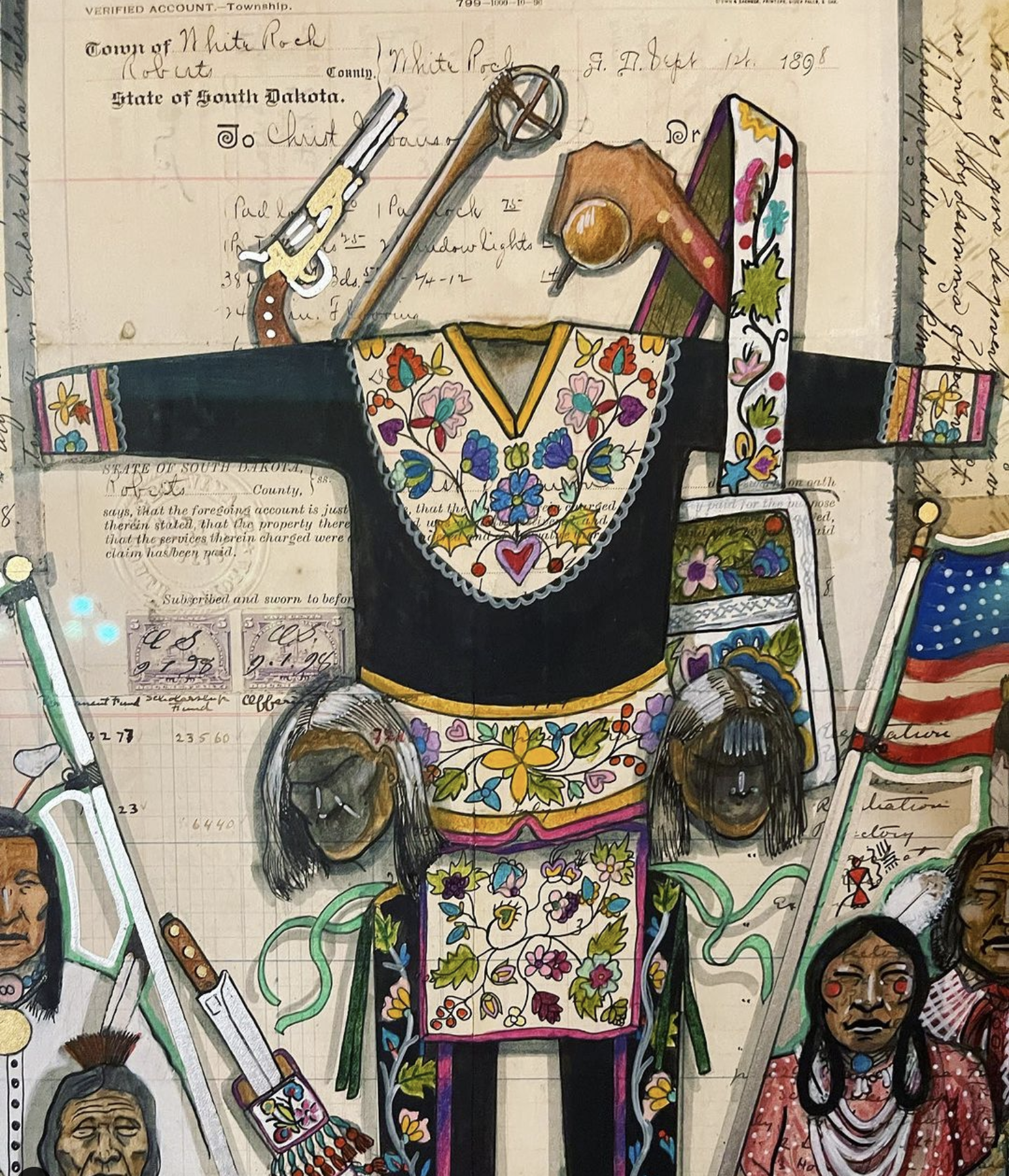
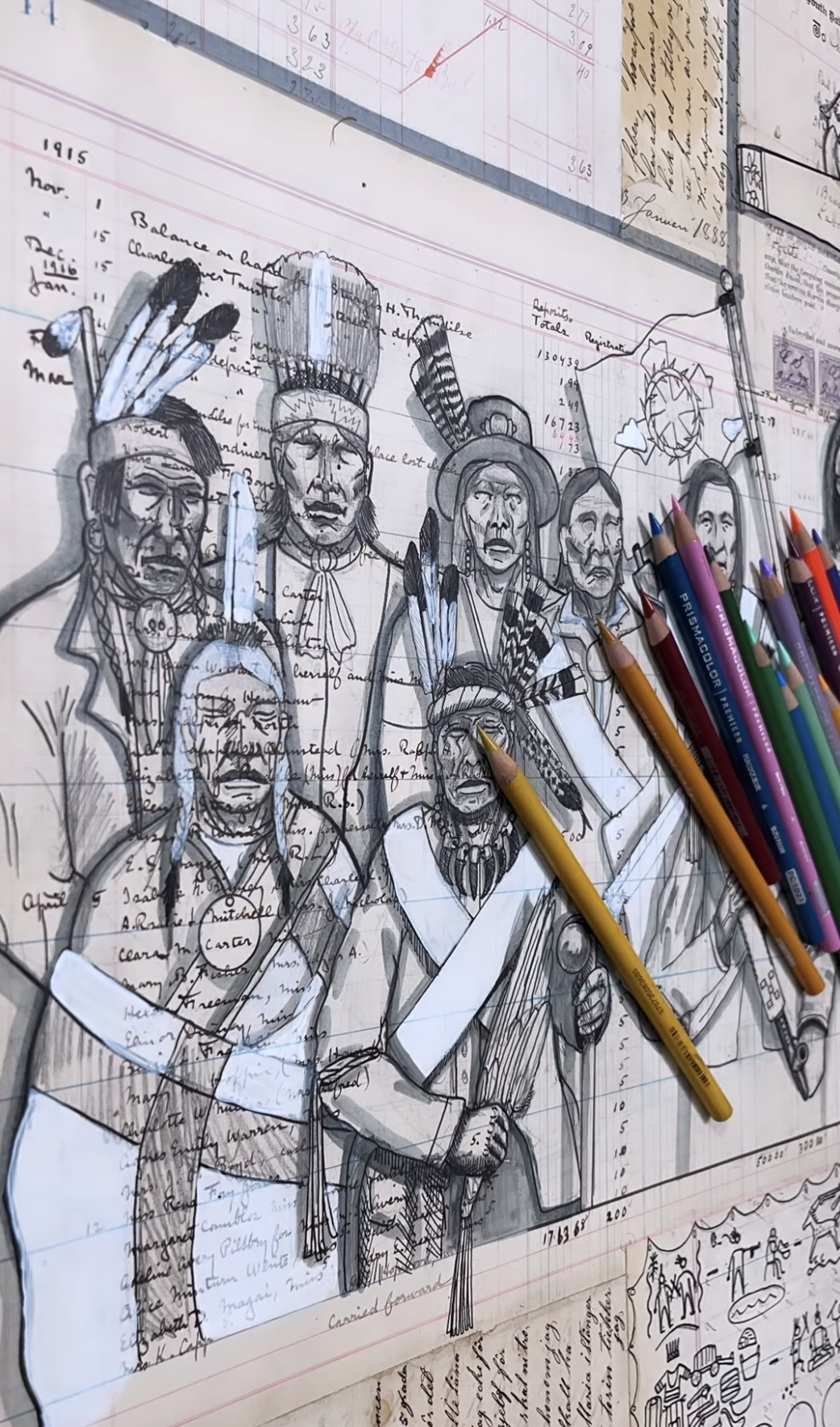
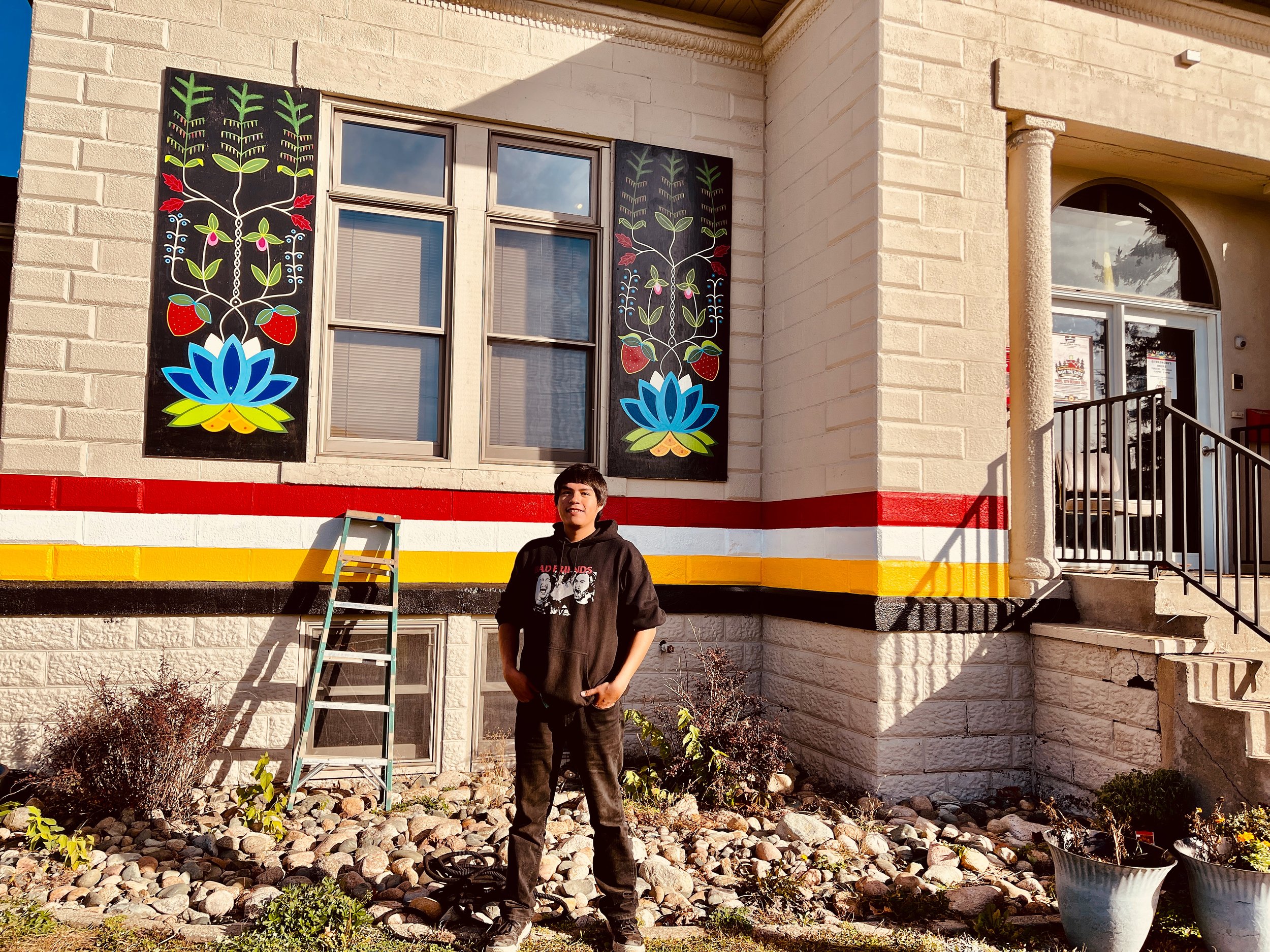


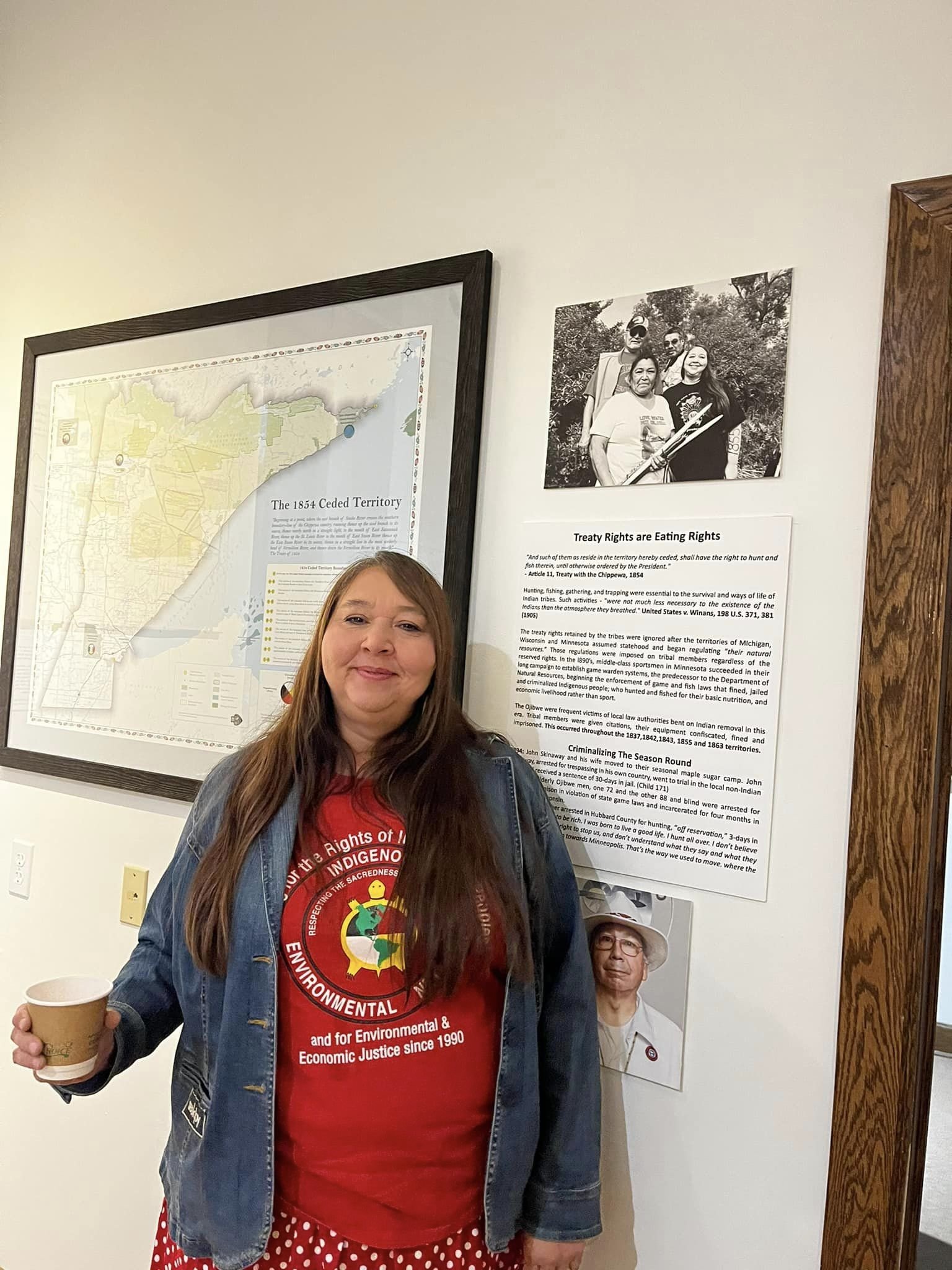
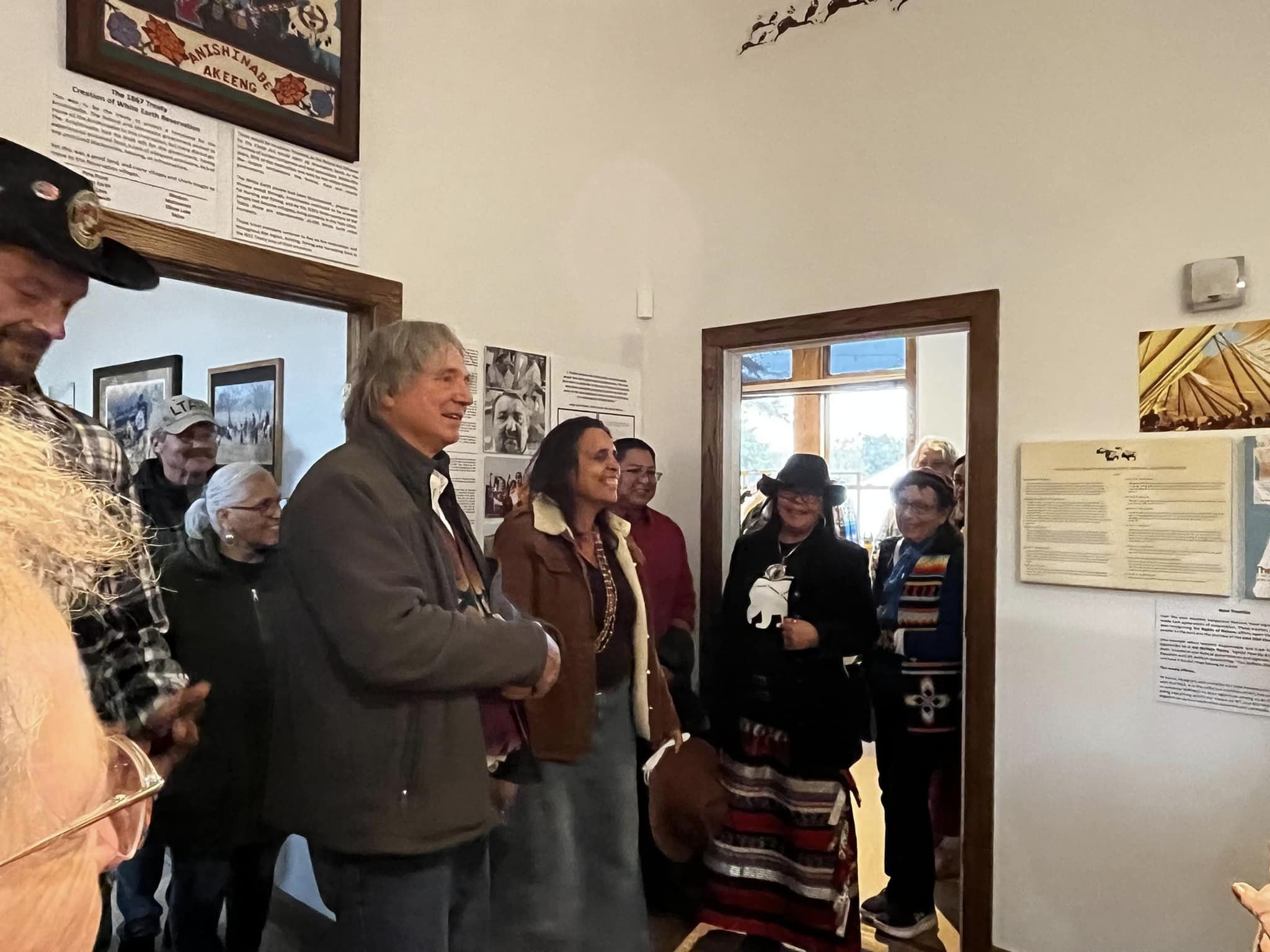
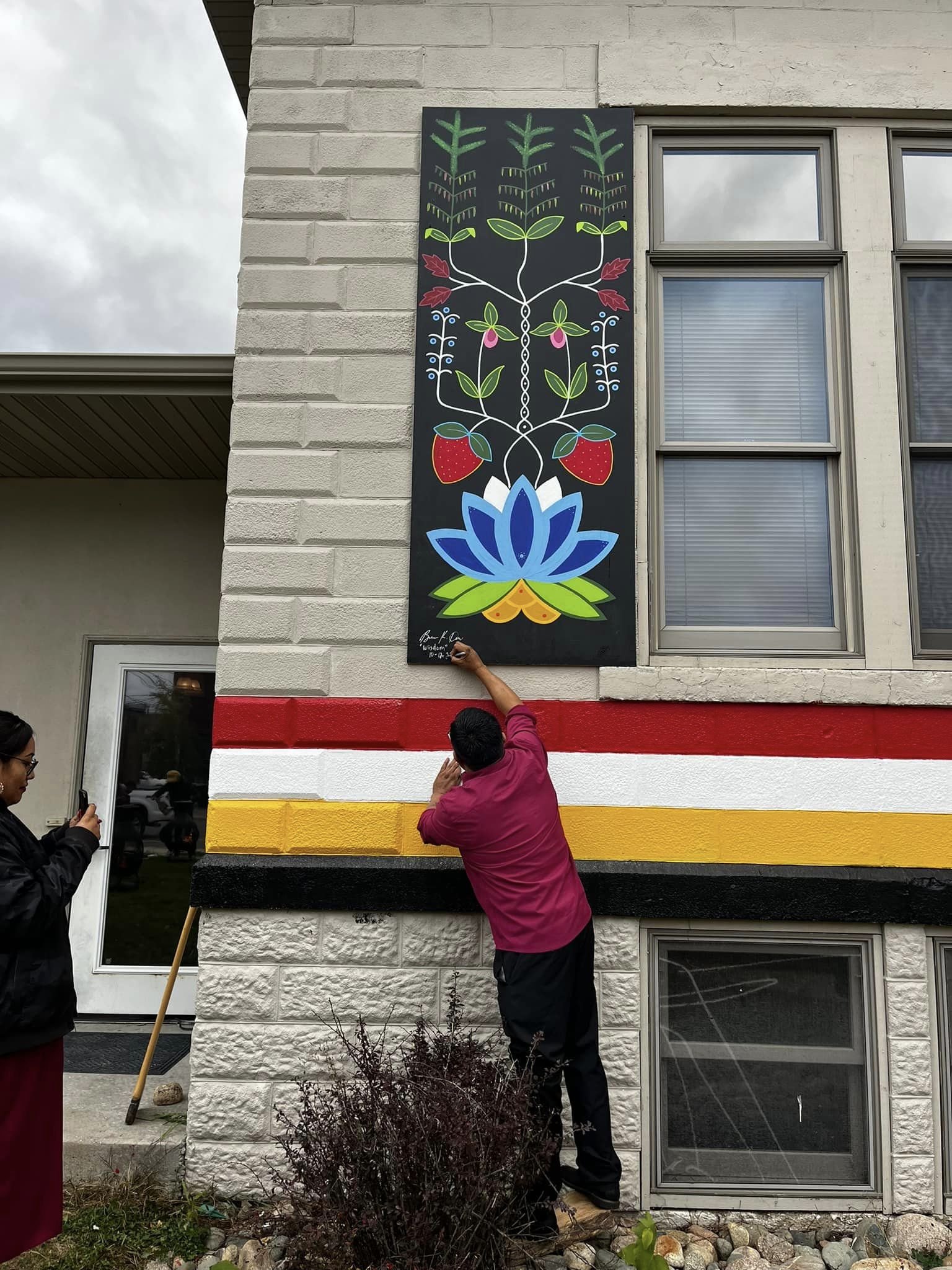
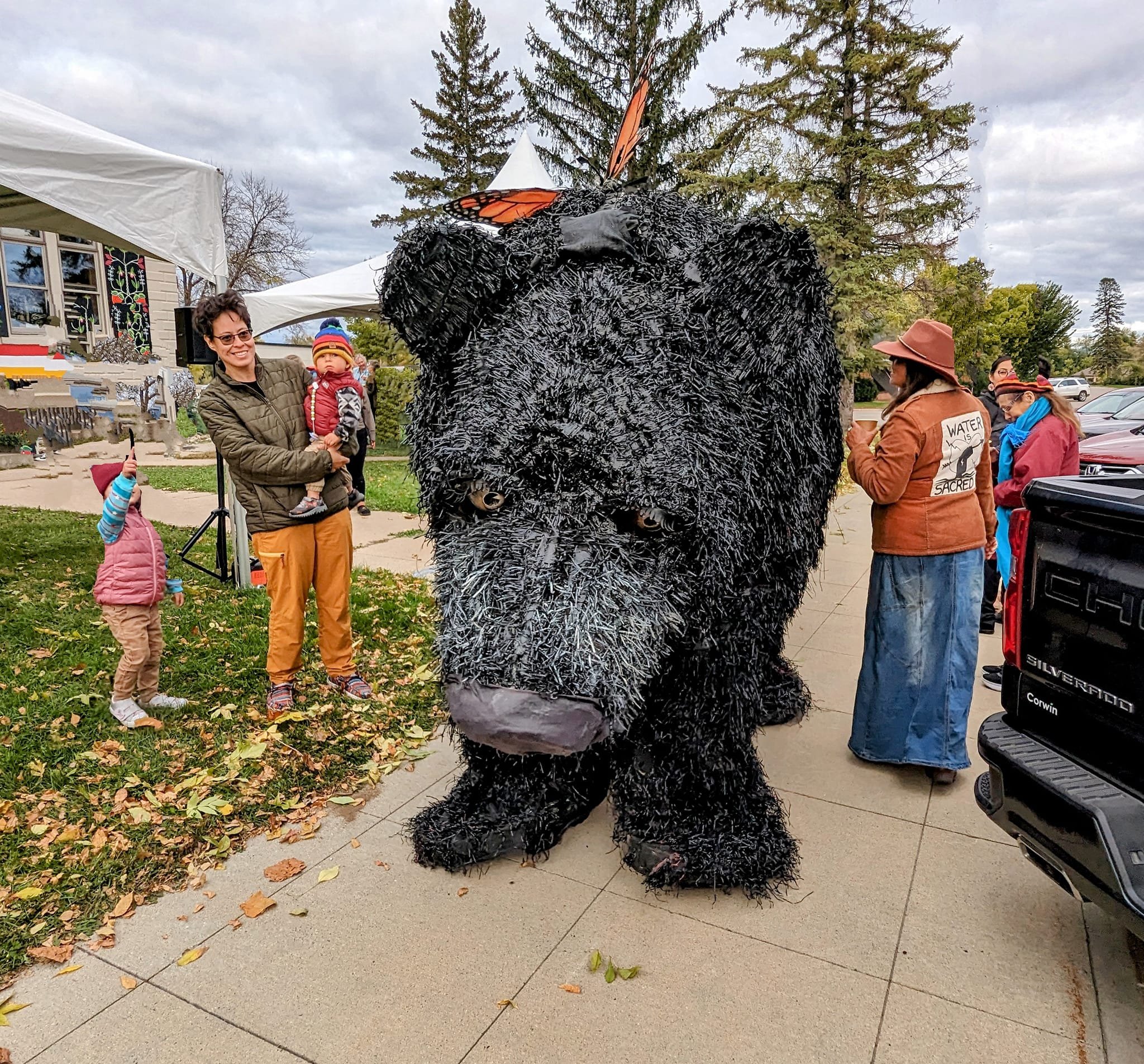
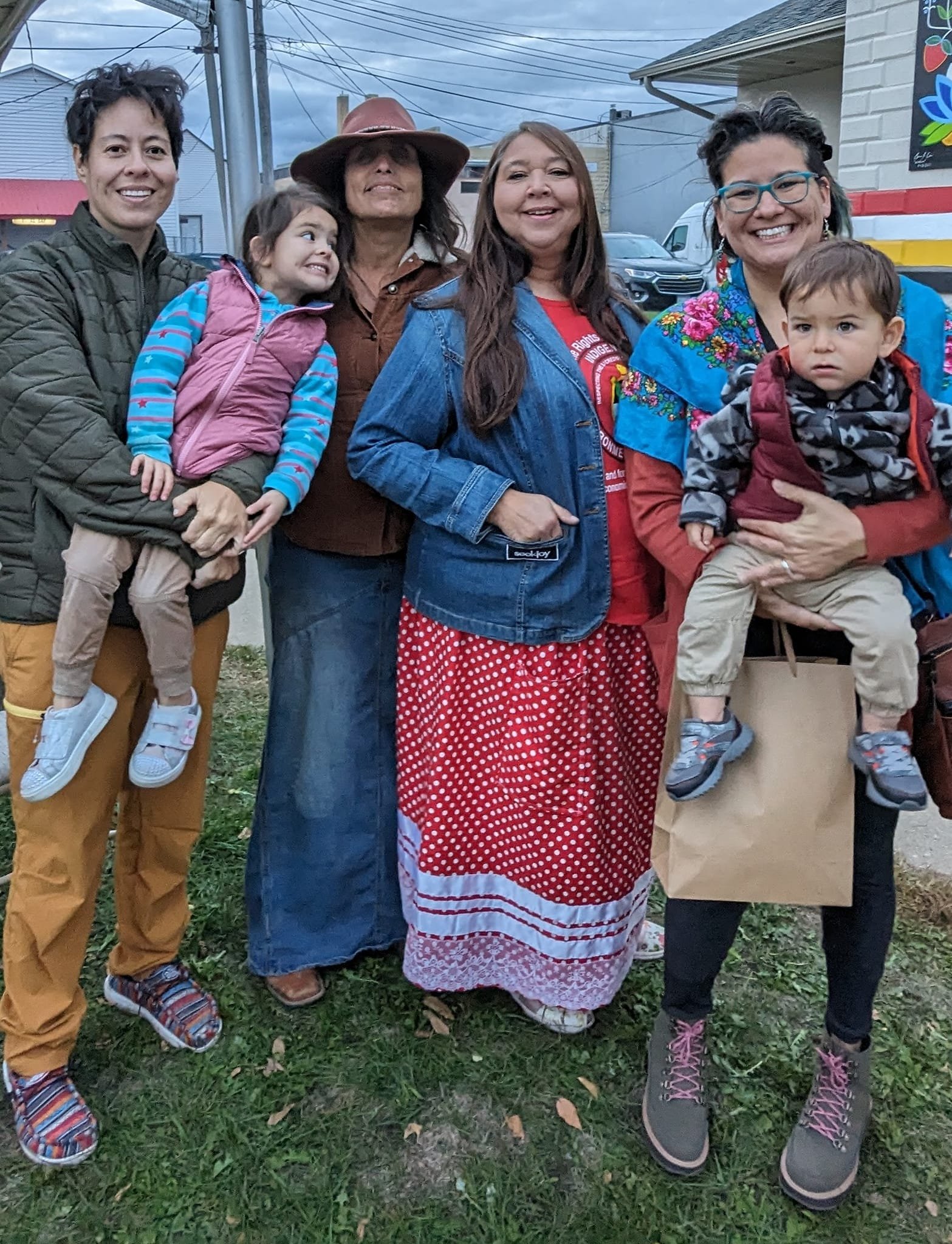

While some elements of the museum’s display will remain, such as the thousand-plus years of Anishinaabe history that provides a backdrop for today’s world, other exhibits will change as new stories are told. The Inkpa Mani Sweet Corn Treaty Painting, commissioned on the right, is just one example of the storytelling work underway at Giiwedinong.
The museum intends to both provide educational materials for schools regionally as well as the general public, and now is seeking to grow a staff and capacity to carry on the work ahead. We have some volunteer support for curriculum development , and plan to dramatically expand our educational work.
Our gift shop is just opening, and will carry an on line presence for most of the organizations work from wild rice, to artisan gifts, books and educational materials.
The team hopes that the museum will serve the community, native and non-Native to grow a better understanding of our history and future.
Giiwedinong has a small board, of Travis Zimmerman (Grand Portage) who directs the Mille Lacs Indian Museum, Danette Larson, who directs the Park Rapids Indian Education Programs for the School District and Don Wedll, the Mille Lacs tribal historian. We will expand this board over the winter, as we develop the programs.
Board member of Giiwedinong, Travis Zimmerman, told Minnesota Public Radio, “A museum run by an American Indian organization, having American Indian curators, and really having that Native voice come out, is something that you don’t really see much of, anywhere really, much less in Minnesota.”
Sarah LittleRedfeather (Giiwedinong co-curator, marketing director and artist). Minnesota Public Radio, “Anishinaabekwe descendant of White Earth, photographed many of these protests. She is also a curator and marketing director for the museum.”
“We had tens of thousands of people at Standing Rock. I was there. And I want to honor that. There were a lot of atrocities that happened,” she says. Curating the museum has been healing, she says.
“It was pretty brutal, what we all went through, and I just feel really energized and I'm so happy to share and carry this on,” Sarah LittleRedfeather says. “I'm really excited to have folks come in and see how beautiful we are.”
We had a beautiful Grand Opening with hopes that Giiwedinong will serve the community, native and non-Native to grow a better understanding of our history and future. We are grateful for communities who came out at our Grand Opening. We hope to fund this work through a combination of memberships and foundation support.
Donor Needs: Capacity Building Funds
The News Resources and Photos below of the opening event.

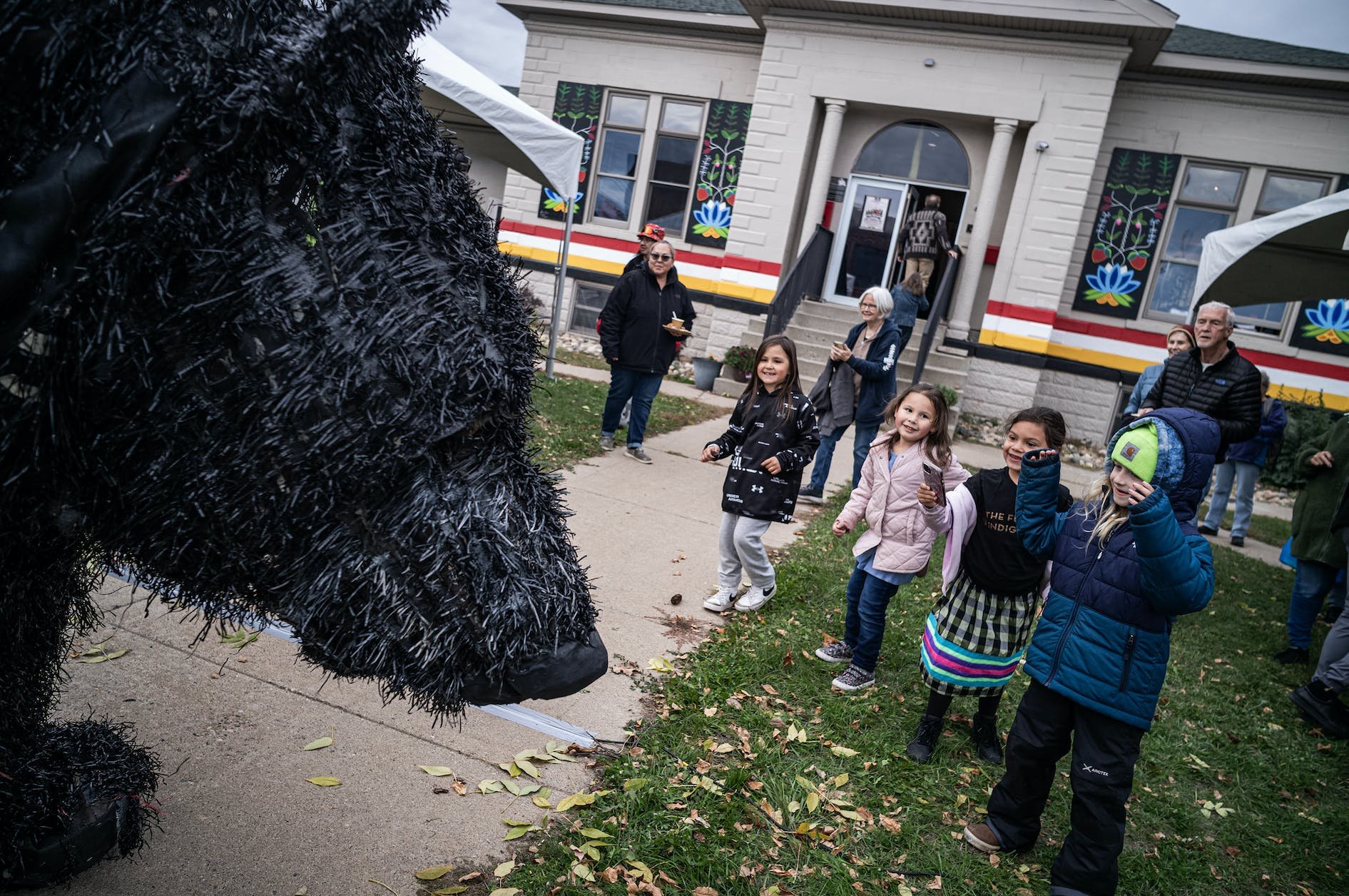

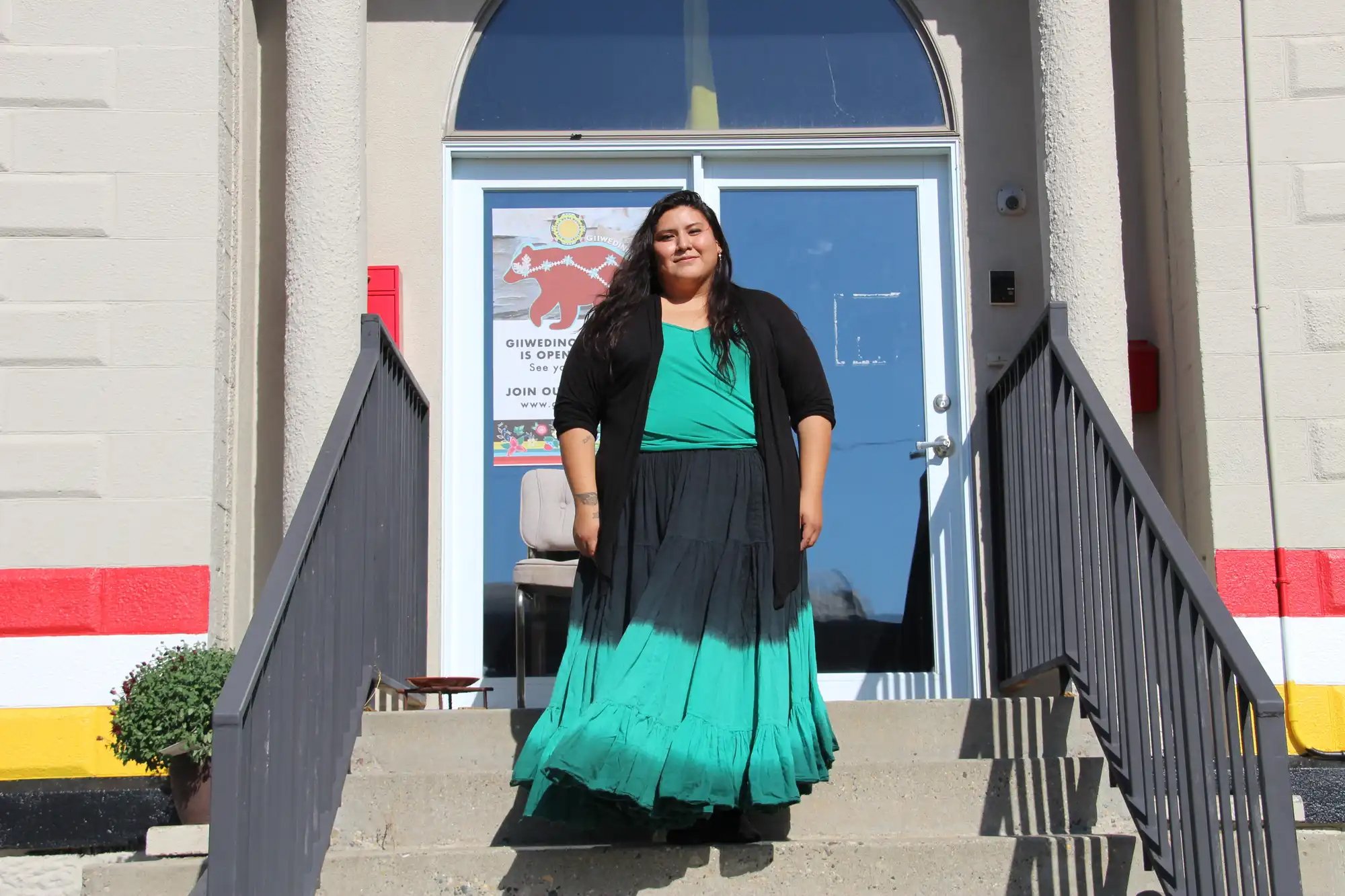
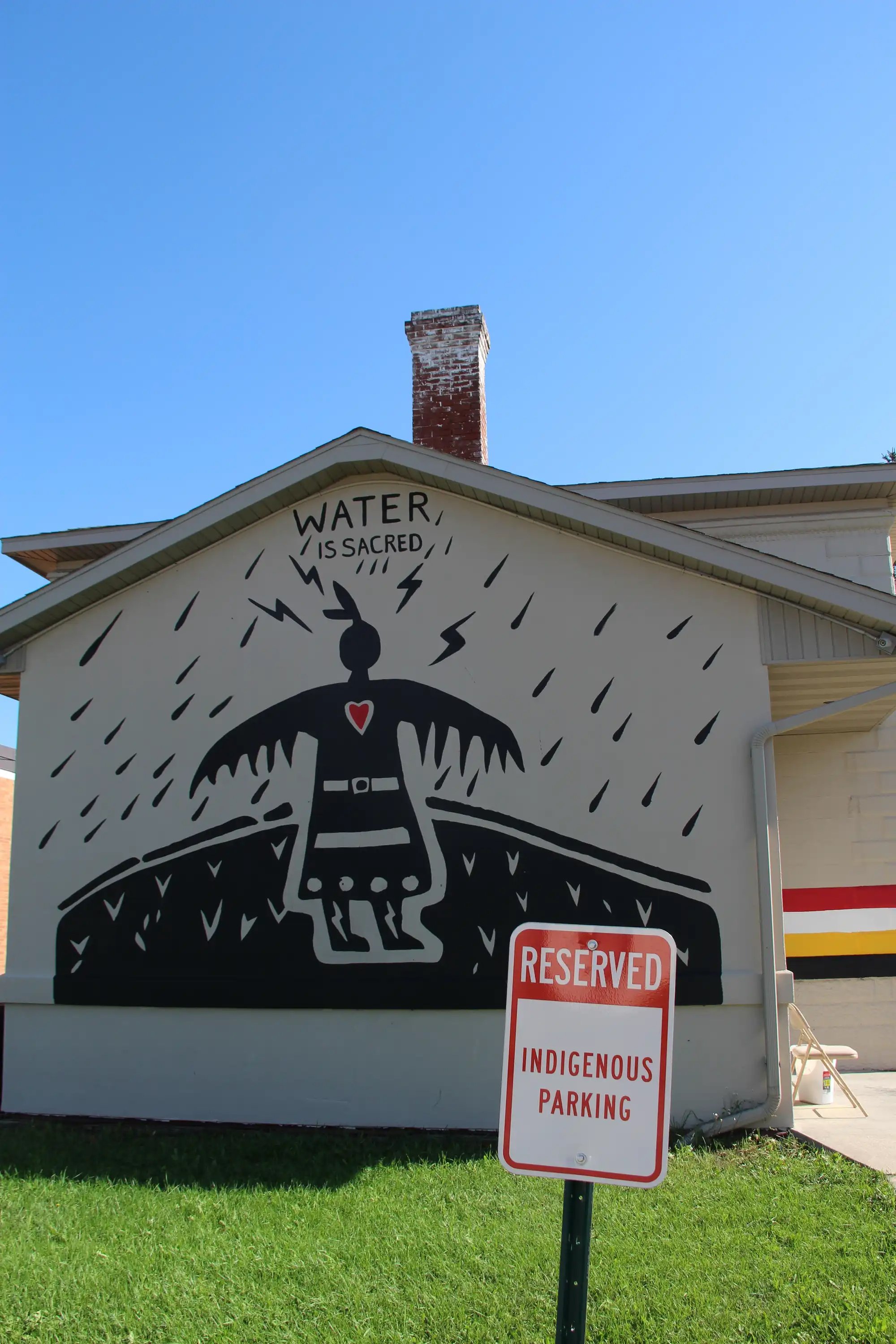
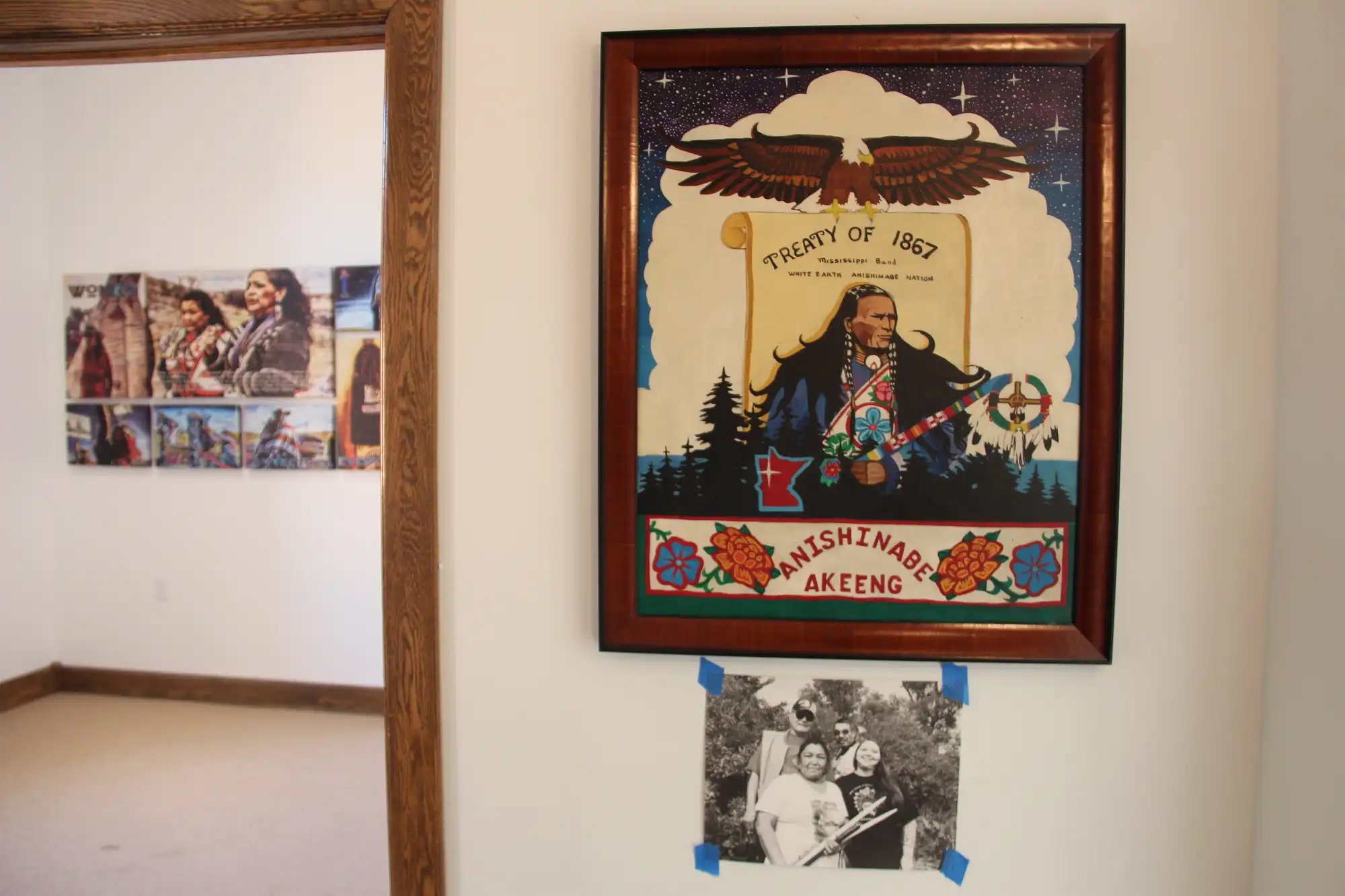
See the MPR News ‘In the North’ – Minnesota’s first independent Indigenous museum opens in an ‘ironic’ location.’ Alex V. CipollePark Rapids, Minn.October 12, 2023
See the Park Rapids Enterprise News “Giiwedinong Museum celebrates Anishinaabeg culture“ By Lorie Skarpness October 16, 2023
See the Star Tribune News “American Indians once protested outside the old Park Rapids library. Now they have a museum there.” By Randy Furst October 19, 2023 (article correction Frank Smoot was not curator of the exhibits)
Giiwedinong Museum begins outside Design
Giiwedinong Museum begins outside Design with artist Brian Dow featuring Isaac Murdoch’s artwork.
“There’s a real need for the history of Akiing, or northern Minnesota to be told and shared from an Indigenous perspective”
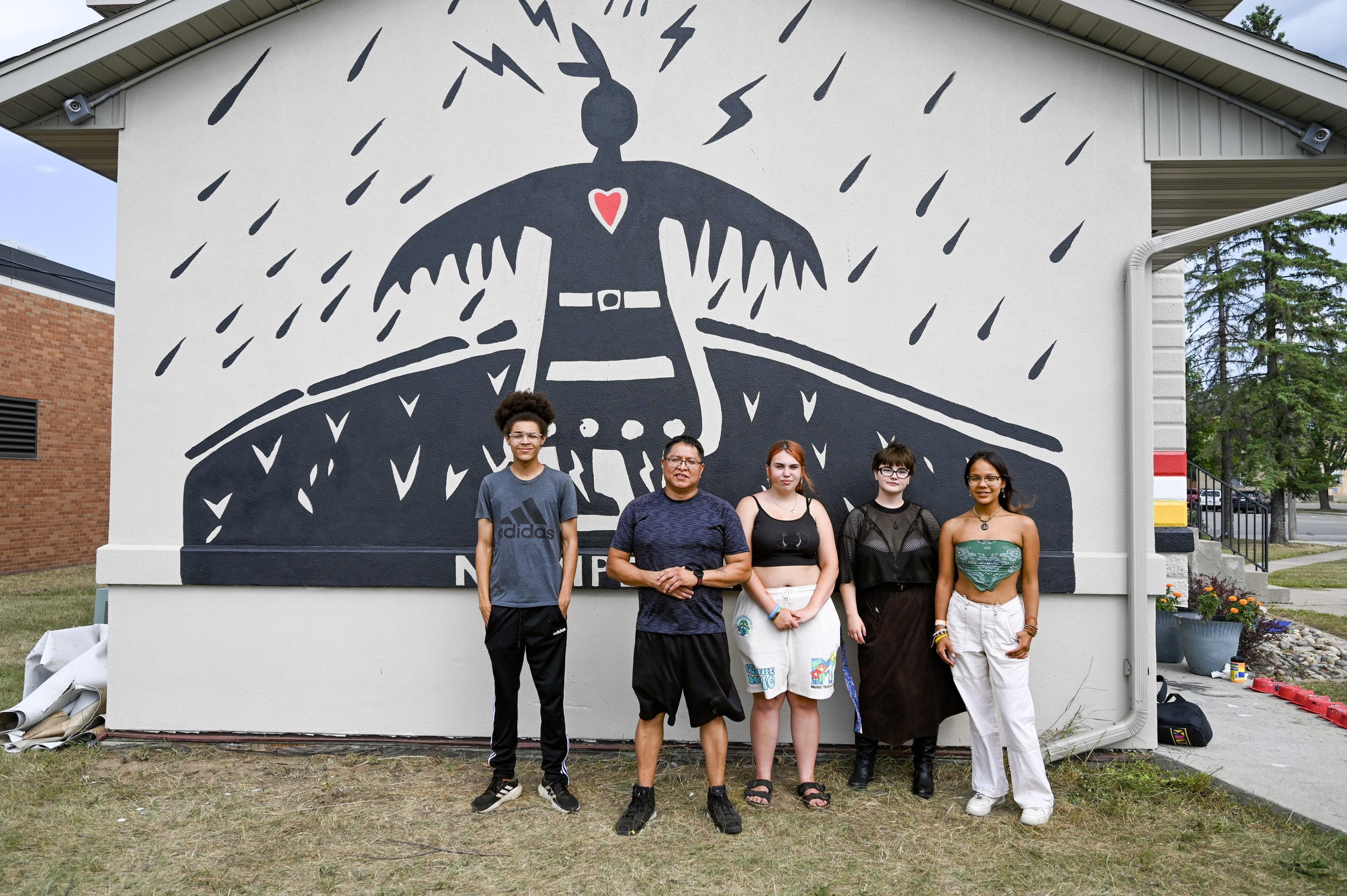
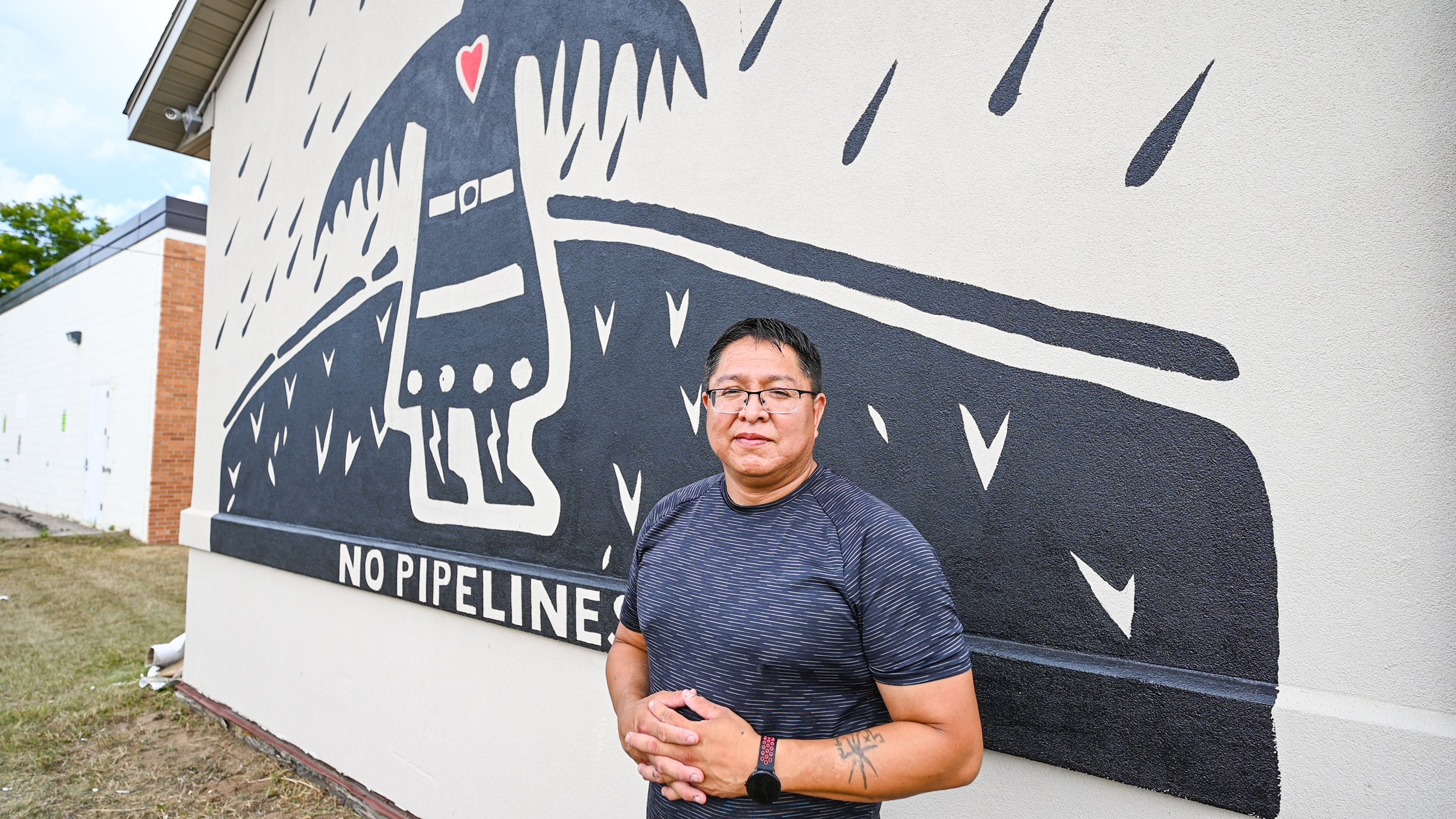
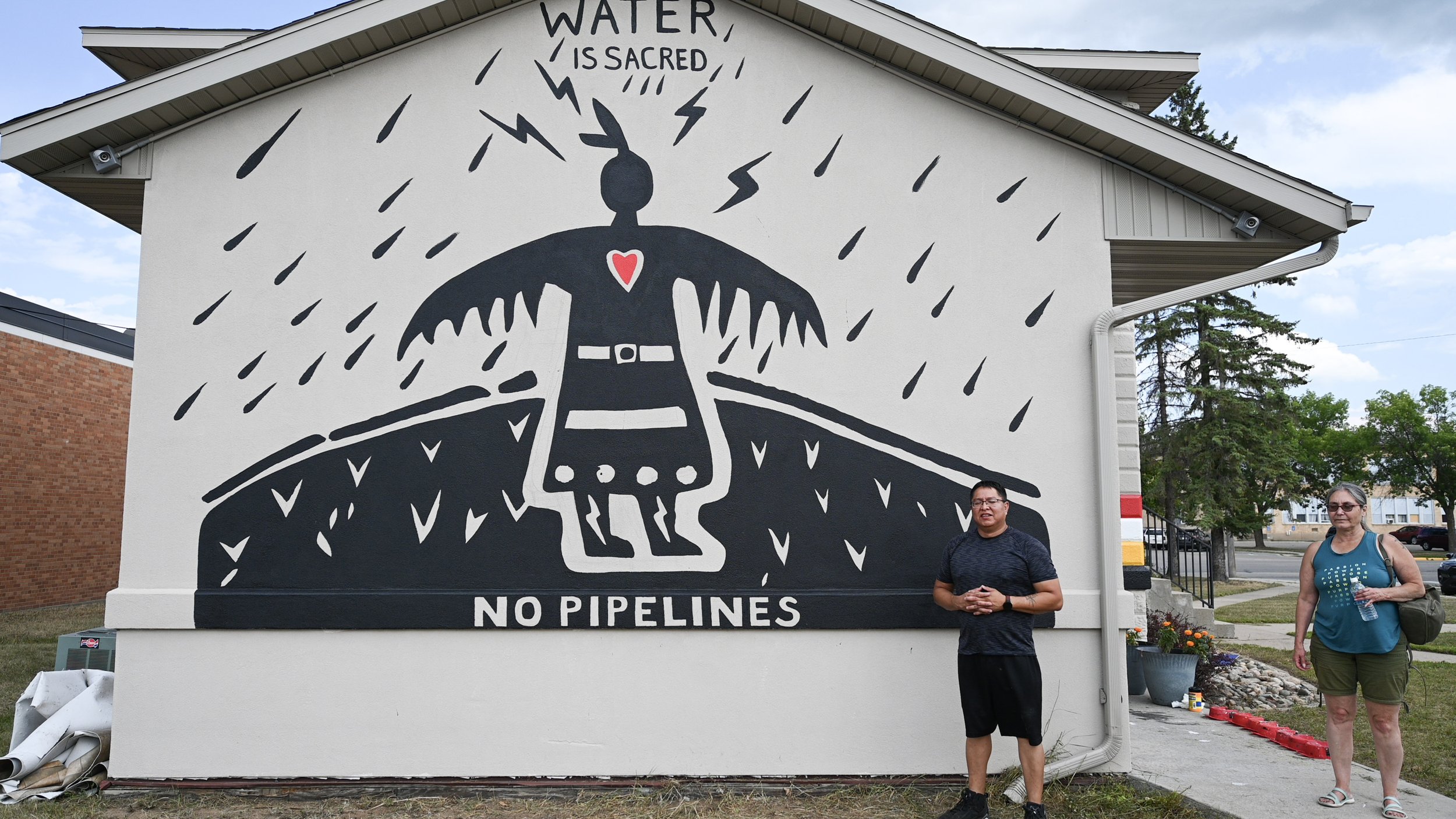
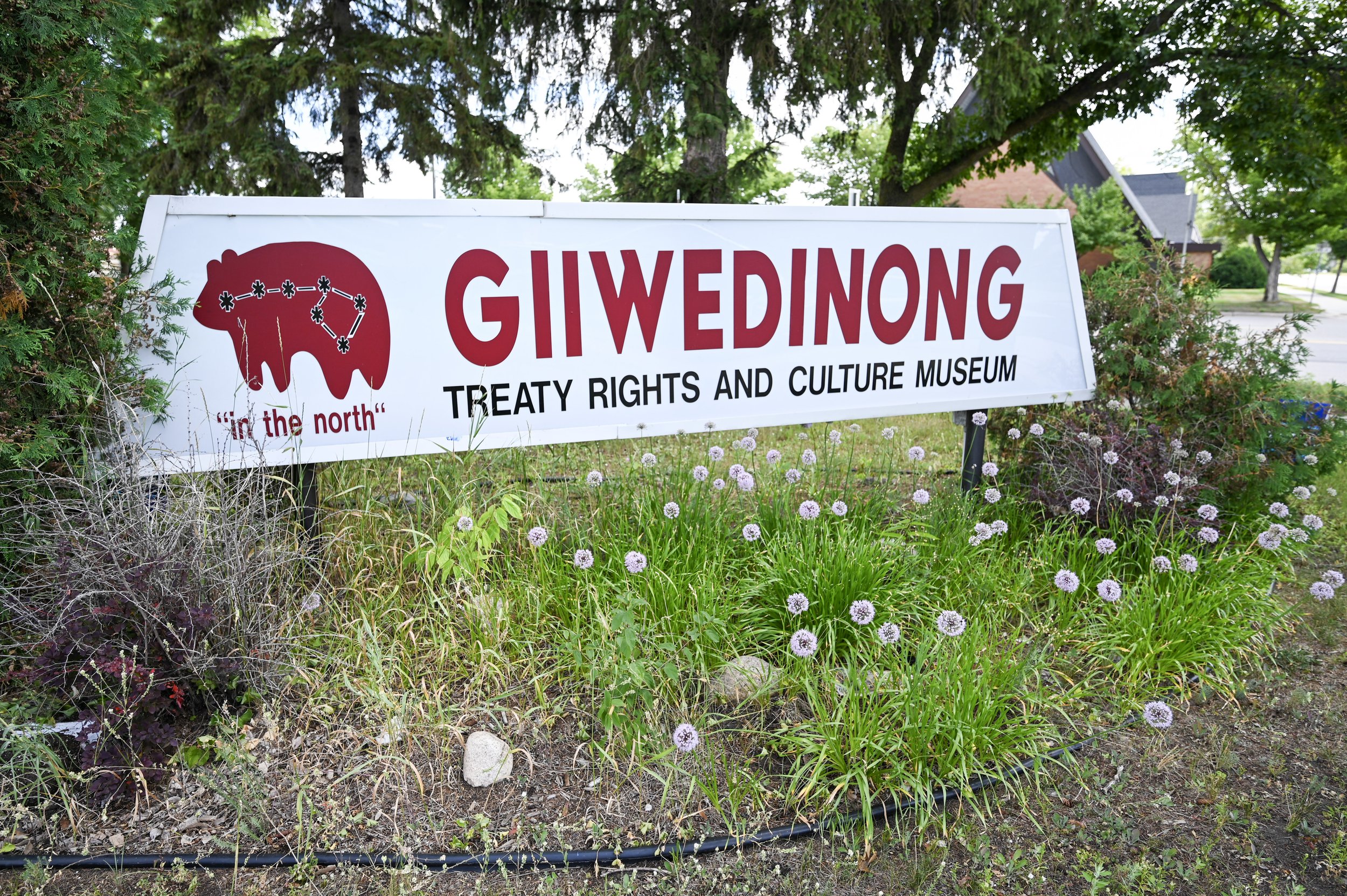

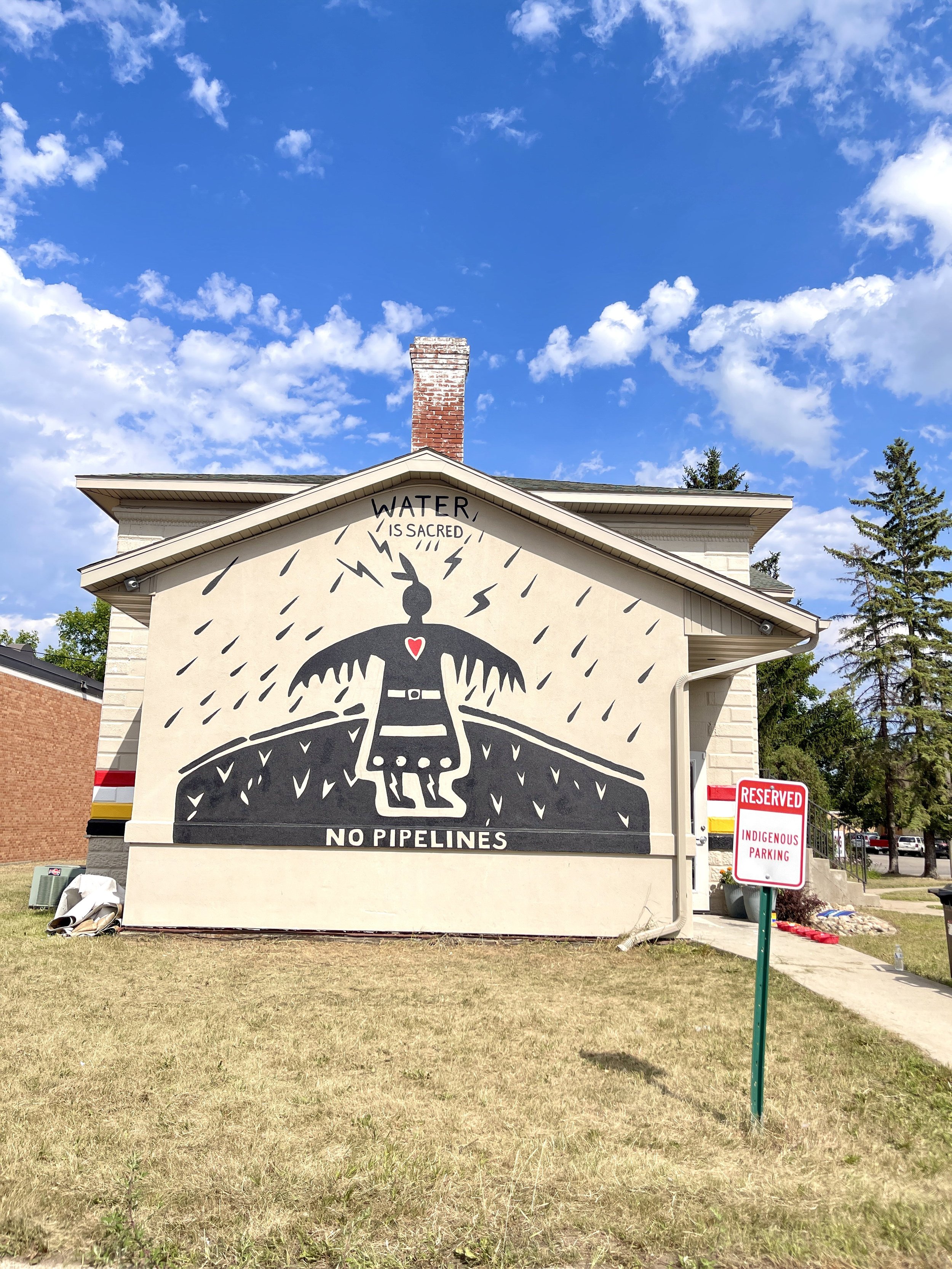
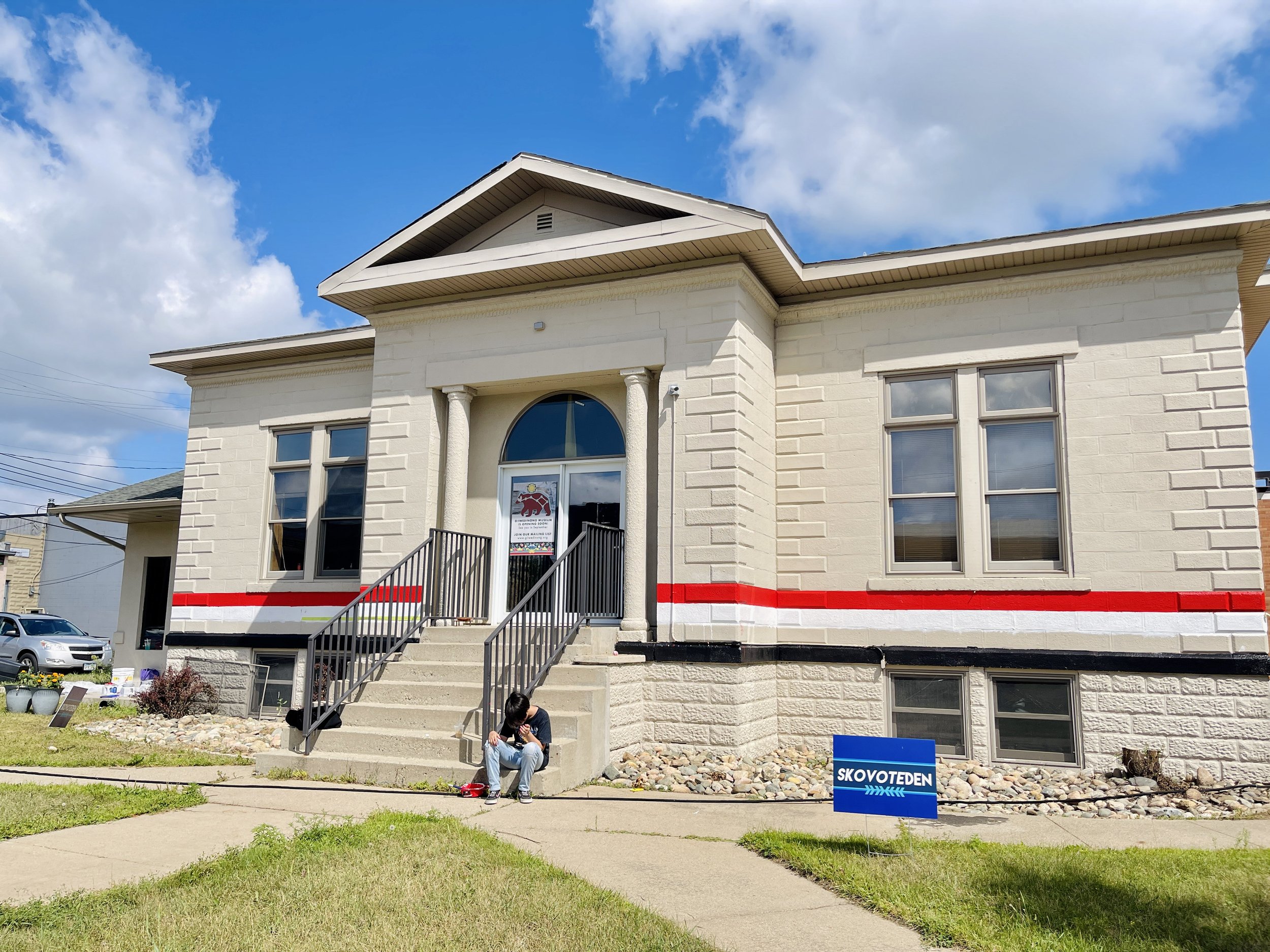
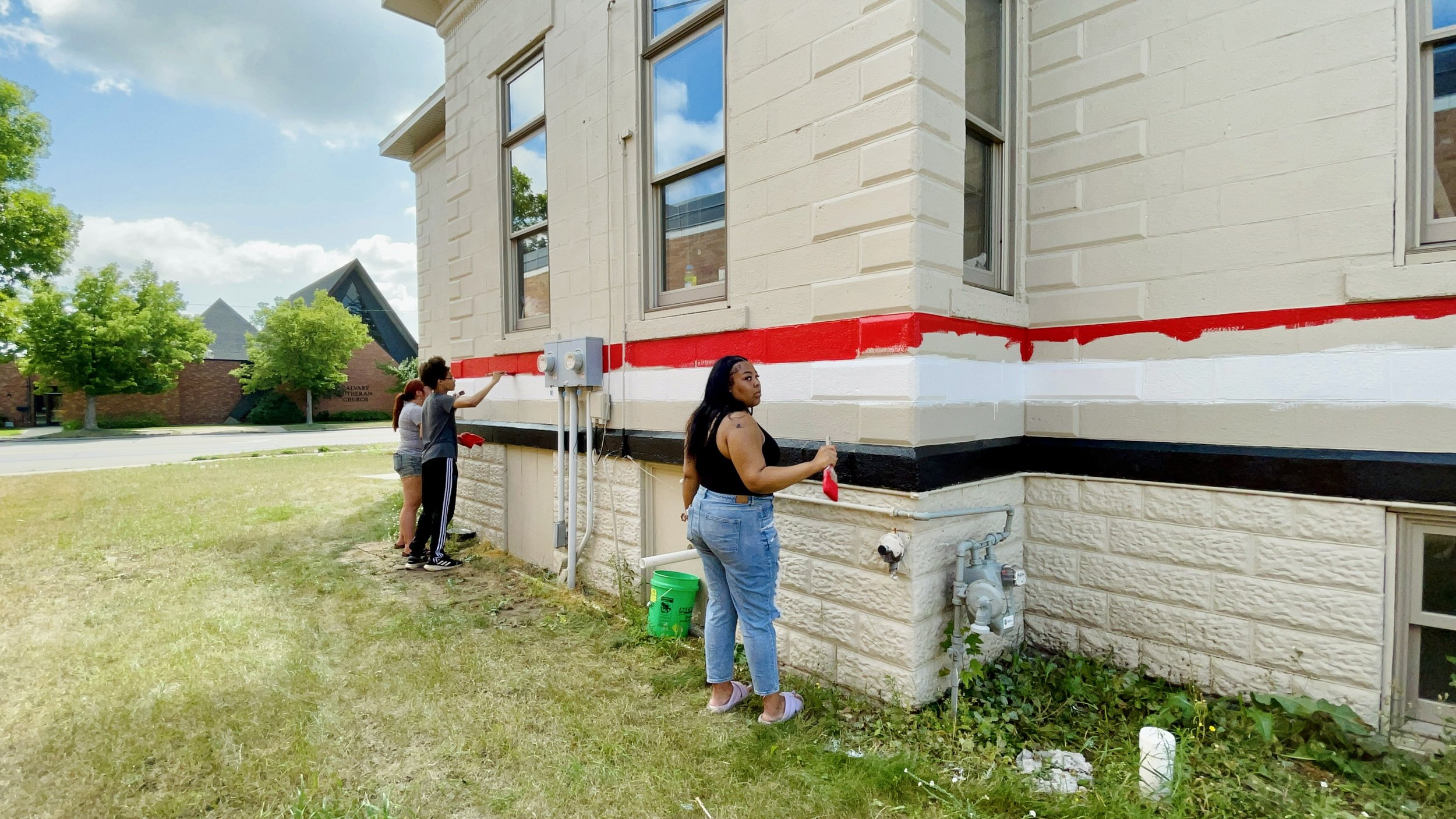
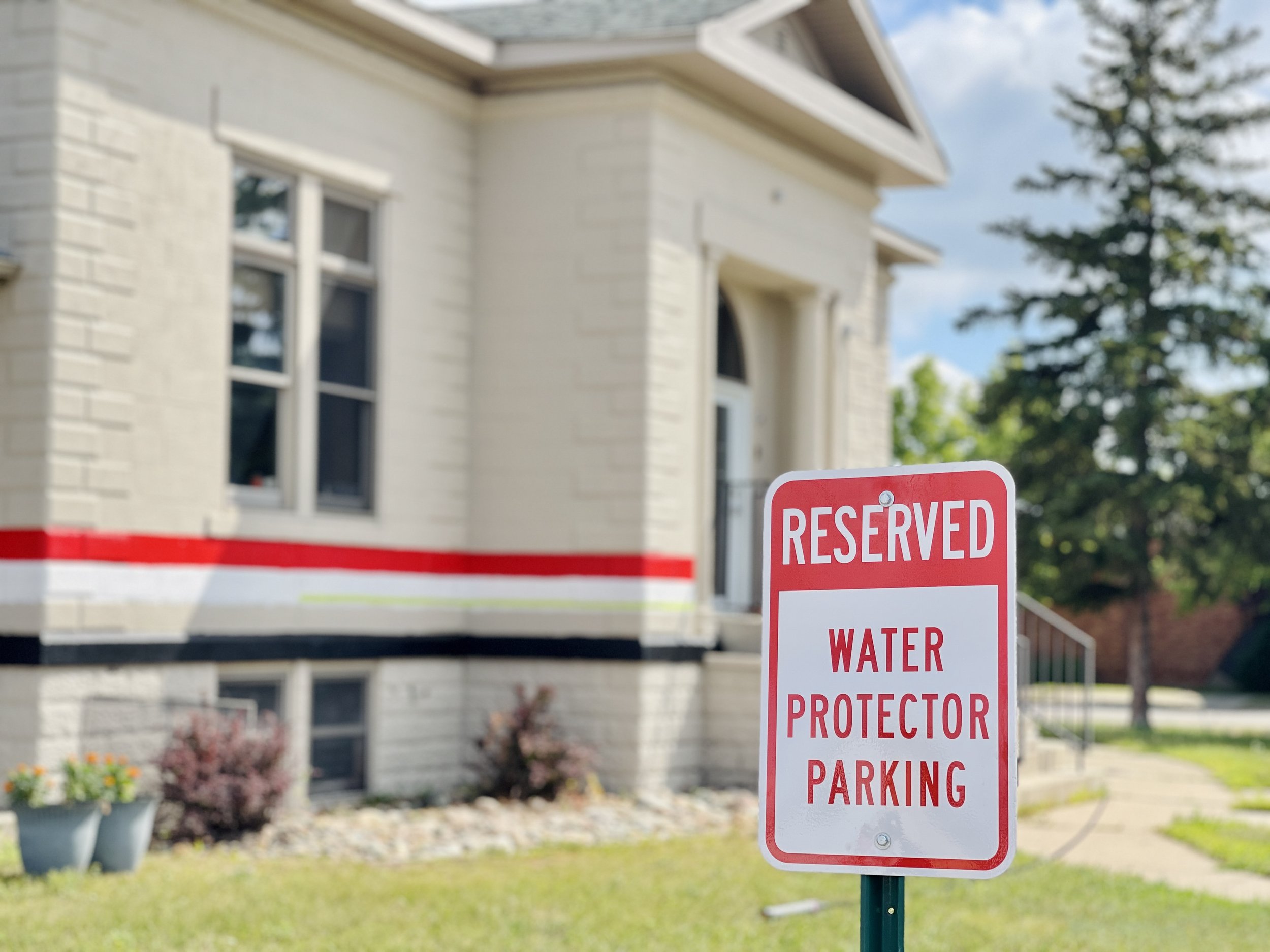
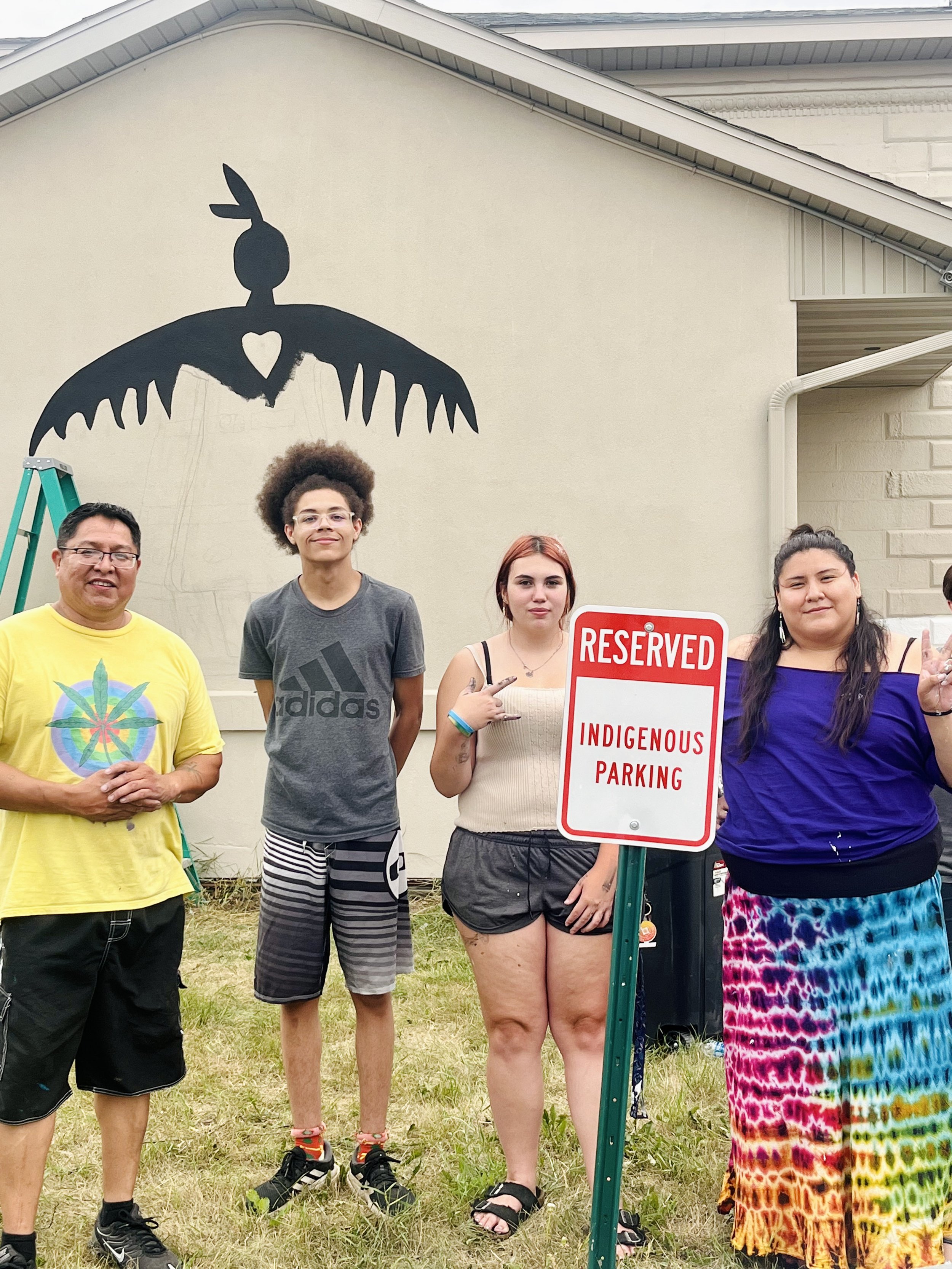
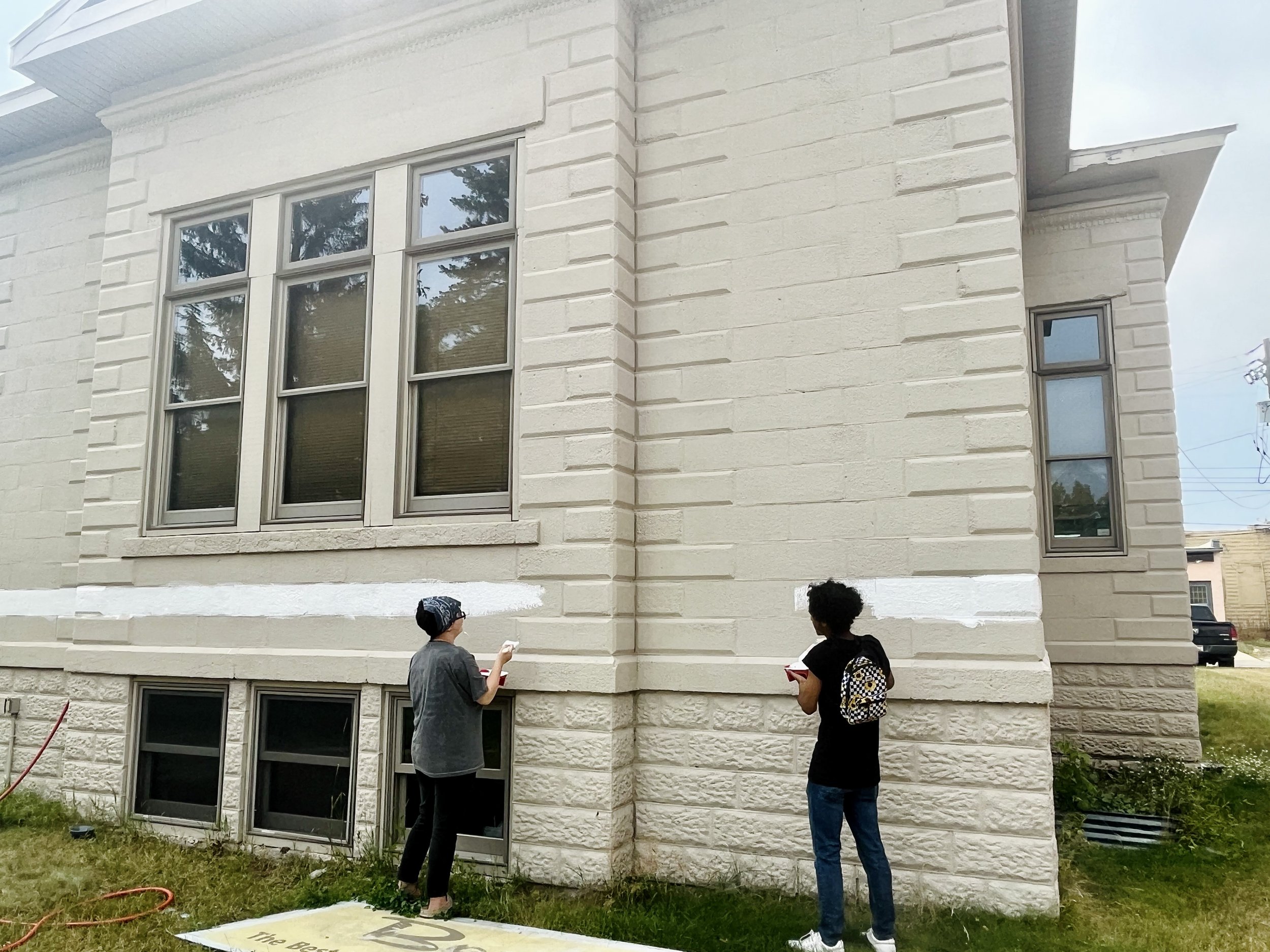
Giiwedinong, the Anishinaabe Museum of Treaties and Culture is beginning to take form in downtown Park Rapids, MN.
This week, artist Brian Dow tribal member of the Red Lake Band of Chippewa Indians (Miskwaagamiiwi-Zaagaiganing) began mural and ribbon trim paintings on the former Carnegie Library and Enbridge office. Dow, a well known painter, graphic artist and clothing designer will work with traditional Anishinaabe beadwork designs. Dow with Mary Crystal Goggleye led a group of youth in creating a Water Protector mural by Isaac Murdoch on the building’s western wall.
The Giiwedinong Museum began as a project funded by Honor the Earth and Akiing, an Anishinaabe Community Development organization.
In October of 2022, Akiing purchased the Carnegie building and has been undertaking essential renovations to prepare for the exhibits. The museum plans to open in October 2023, two-years after Enbridge Line 3 Pipeline went into operation. The Museum will feature a prominent Water Protector exhibit, including photos, stories and narratives from the Water Protector movement in both northern Minnesota and Standing Rock.
“We want to share our history, and honor water protectors in this work. Many people who want to learn about citizen engagement, regulatory processes , treaty rights, and history of Minnesota will be pleased to come to our museum,” Winona LaDuke who is coordinating the project for Akiing explained.
Renee Gurneau, Board Chair of the newly formed Giiwedinong Museum, from Red Lake Band of Chippewa Indians (Miskwaagamiiwi-Zaagaiganing), and is helping guide the cultural knowledge of the museum in development.
“There’s a real need for the history of Akiing, or northern Minnesota to be told and shared from an Indigenous perspective, “ Gurneau said.
Frank Bibeau, Executive Director of Akiing is pleased with the progress of the museum project, “We have a group of hard working people bringing together history, culture, treaty and constitutional rights, and that story will begin a new public narrative in northern Minnesota.”
Museum Exhibit Curator Frank Smoot, presently working with Giiwedinong on loan from the Chippewa Valley Historical Museum, with a multitude of national museum projects, including the Coos History Museum, in Coos Bay Oregon. Smoot is joined by project advisor Lydia Four Horns, both of whom are guiding Akiing staff and community members in developing the exhibits. “We are going to tell the first chapter of a book” Smoot said. “Museums should change and grow, and this is the first set of exhibits, the first chapter”.
The Giiwedinong Museum, funded entirely on private contributions and represents the first independent Indigenous Museum in Minnesota. Giiwedinong plans to develop a supporting membership base, and will also seek funds from state agencies and foundations to support the exhibits and staffing.
“We take the responsibility of telling our stories for the public very seriously,” LaDuke said. “We will do our best to begin telling those stories.” Giiwedinong hopes to hire additional staff this fall, and secure ongoing funding.
During the Giiwedinong’s building dressing Brian Dow said while working at the museum this past week in Park Rapids. (Facebook Live video above)
“This week we are going to begin dressing our building,” Dow said. “We are going to add a lot to Park Rapids in terms of public art, culture and a story.”
We also have been extensively renovating the Gallery and Gift Shop inside including installing for the flooring using hemp wood panels.
Photos and Media by Sarah LittleRedeather
Press Martin Keller, Media Savant Communications
612-729-8585 (land) | 612-220-6515 (cell) |mkeller@mediasavantcom.com
